#Institute for Career in Financial Markets
Explore tagged Tumblr posts
Text
"I’m going to let him go wild on health,” former president Donald Trump said of Robert F. Kennedy Jr. at his Madison Square Garden rally in New York City this past weekend. “I’m going to let him go wild on the food. I’m going to let him go wild on the medicines.”
Kennedy, a former Democrat, suspended his presidential campaign in August and endorsed Trump. He has since launched the Make America Healthy Again campaign, an initiative focused on tackling chronic diseases that Trump has seemingly embraced in recent weeks. Given Kennedy’s anti-vaccination stance and conspiratorial leanings, some policy experts and former government officials are concerned about how his views could shape the nation’s health agenda.
Kennedy has long made false statements about the safety of vaccines and has touted disproven treatments for Covid-19, including ivermectin and hydroxychloroquine. On the campaign trail, he has railed against seed oils, blaming several chronic health conditions on their presence in processed foods.
How much influence Kennedy could have on national health policy will all depend on his role within a future Trump administration. Trump did not clarify his remarks at Sunday’s event, including what position he is considering Kennedy for. According to a CNN report that ran late Tuesday, Kennedy said Trump “promised him control of the public health agencies,” but in an email to WIRED on Wednesday, Steven Cheung, Trump’s campaign communications director, said that formal discussions of who will serve in a second Trump administration are premature.
Trump could be considering Kennedy to lead the Department of Health and Human Services, which has 80,000 federal employees, or one of the agencies within it, such as the Food and Drug Administration or the Centers for Disease Control and Prevention. It would be a departure from his previous top health picks, who had lengthy government or public health careers. For instance, Alex Azar, Trump’s HHS secretary, was deputy HHS secretary under George W. Bush and an executive at drugmaker Eli Lilly. Scott Gottlieb, a physician and investor appointed as FDA commissioner under Trump, had previously worked for the FDA and had served on the boards of pharma and biotech companies.
When asked to elaborate on Kennedy’s health priorities, Amaryllis Fox Kennedy, the former candidate’s campaign director and daughter-in-law, told WIRED: “Bobby aims to end conflicts and corruption at the agencies, ensure all testing is undertaken by scientists who have no financial interest in the outcome, and all results of all trials are released to the public. The free market will take care of it from there.” (The National Institutes of Health already requires results of clinical trials funded by the agency to be published to a government database.)
Jerome Adams, US surgeon general under Trump and current executive director of health equity initiatives at Purdue University, says that even if Kennedy were tapped to lead HHS, the FDA, or the CDC, it’s unlikely that he would ascend to one of those roles due to his lack of medical training and controversial views on public health issues. “Congressional approval is required for these positions, and his stances could be a barrier,” Adams says.
If Republicans control the Senate after next week’s election, though, that calculus could change. “The GOP has generally fallen into line in terms of supporting candidates that President Trump does,” says Genevieve Kanter, associate professor of public policy at the University of Southern California.
If chosen to be FDA commissioner, Kennedy would control the agency’s budget and priorities and could have a sizable impact by installing lower-level appointees who are sympathetic to his worldview. While the FDA commissioner does not single-handedly approve or authorize new drugs, Kantner says outside political pressure can certainly influence that process. Kennedy could also appoint members to FDA advisory committees, panels of outside experts that make recommendations to the agency on drug approvals and other regulatory matters. The FDA often follows the recommendations of advisory committees when making decisions on new drug approvals, but not always.
The FDA can also choose to not enforce some rules in certain circumstances—what’s known as enforcement discretion. Given his support for dubious and unproven therapies, such as stem cells and hyperbaric oxygen, an FDA under Kennedy, for instance, could choose to not go after companies that market unapproved treatments.
“When we think of the kind of person we want to be head of HHS or be FDA commissioner, someone ‘going wild’ isn’t exactly the first trait that comes to mind,” Kanter says. “It wouldn’t ease the public’s concern that we would see more food safety incidents and adverse events from poorly regulated drugs and devices from a lax administration that is known for embracing unscientific theories.”
Kennedy wouldn’t have free rein though. Existing laws and regulations govern how the agency works, and a new FDA commissioner wouldn’t be able to get rid of those quickly. “If you’re dealing with regulatory issues that have been long-standing and have lots of precedent, it’s just not possible to turn some of those things around or dismiss them overnight,” says a past leader of the FDA, who requested anonymity so that they could speak freely.
Likewise, even in a leadership role at HHS or the CDC, Kennedy wouldn’t be able to easily affect vaccine policy. Vaccine recommendations are made by the Advisory Committee on Immunization Practices, which comprises outside medical and public health experts. Georges Benjamin, executive director of the American Public Health Association, says Kennedy could try to stack that advisory committee with people who are sympathetic to his views on vaccination, but those members are chosen through a rigorous nomination process.
“He could certainly change policy that way, but it takes a while and it won't be a secret. There are ways in which the public can push back, including taking a case to court,” he says.
Kennendy could have influence in other ways beyond direct control of a public health agency. Trump could potentially bring Kennedy on as a White House adviser, which wouldn’t require approval by the Senate.
“Without congressional vetting and oversight, there is potential for unchecked impact. RFK's views could shape health policies, raising concerns about misinformation and harm,” Adams says.
Karoline Leavitt, national press secretary for the Trump campaign, told WIRED in an email that if reelected, Trump will establish a “special Presidential Commission of independent minds and will charge them with investigating what is causing the decades-long increase in chronic illnesses.” She did not say whether Kennedy would be chosen for that task force.
Kennedy has also been sizing himself up for another position in a potential Trump cabinet: agriculture secretary. A longtime environmental activist, Kennedy has promised to take on big farms and feedlots, reduce pesticides, and fix what he presents as a food system captured by corporate interests. “When Donald Trump gets me inside,” Kennedy said in a video shot outside the Department of Agriculture headquarters in Washington, DC, “it won’t be that way any more.”
This platform is a continuation of Kennedy’s long history as an antagonist against the agriculture industry. In 2018, Kennedy and a team of attorneys won an initial $289 million settlement against Monsanto, representing a groundskeeper who developed cancer after being soaked with a herbicide made by the agrochemical firm. He also attempted to sue the pig farming company Smithfield because of its production of hog manure, although that case was thrown out by a federal judge.
Kennedy’s past makes him an unlikely candidate for agriculture secretary, according to Daniel Glickman, who served in the role during Bill Clinton’s presidency. “It’s hard for me to imagine, given Trump’s traditional base in the heartlands, that he would pick somebody who was an advocate for breaking up large farms and breaking consolidated agriculture,” says Glickman.
Like top posts at HHS, the USDA secretary position would need to be confirmed by a Senate vote. “I don’t think [Kennedy] is a slam dunk,” says Glickman.
Trump’s pick for USDA chief during his first term was Sonny Perdue, a former governor of Georgia and founder of an agricultural trading company. Most agriculture secretaries either have a background in the industry or politics—two crucial constituencies for the person who will be in charge of a department that employs nearly 100,000 and is made up of 29 agencies, including forestry, conservation, and nutrition programs. “The difference between Sonny Perdue and Robert F. Kennedy, Jr. is like night and day,” says Glickman.
If Kennedy were to be confirmed as agriculture secretary, he might struggle to enact the most radical parts of his program. He is an outspoken critic of pesticides, but the USDA is generally not in charge of regulating those, says Dan Blaustein-Rejto, director of agriculture policy and research at the Breakthrough Institute. Rather, the EPA regulates pesticides with public health uses.
Although he may not be able to directly influence pesticide regulations, Kennedy has said he would try to “weaponize” other agencies against “chemical agriculture” by commissioning scientific research into the effects of pesticides. The USDA Agricultural Research Service has a nearly $2 billion discretionary budget for research into crops, livestocks, nutrition, food safety, and natural resources conservation.
There are other levers that an agriculture secretary could pull, says Blaustein-Rejto. The USDA is investing $3 billion through the partnership for climate-smart commodities—a scheme that’s supposed to make US agriculture more climate-friendly. A USDA chief might be able to put their thumb on their scale by influencing the selection criteria for these kinds of programs. The USDA also oversees the Commodity Credit Corporation (CCC), which has a $5 billion fund that it uses to support farm incomes and conservation programs, and to assist farmers hit by natural disasters. It’s possible that a USDA chief could influence how these CCC funds are distributed by the agency.
Kennedy has also argued that corporate interests have captured the US’s dietary guidelines, and he pledged to remove conflicts of interest from USDA groups that come up with dietary guidelines. US dietary guidelines are developed jointly by the USDA and HHS and are updated every five years, giving the agriculture secretary limited opportunities to influence any recommendations.
“If RFK is in a high-level policy role, I expect to see a lot more talk about ultra-processed foods, but I’m not sure what that would actually entail when it comes to the dietary guidelines,” says Blaustein-Rejto.
The experts WIRED spoke with largely think Kennedy’s more extreme positions will likely be constrained by bureaucracy. But the message that elevating a vocal vaccine skeptic and conspiracy theorist would send remains a serious concern ahead of a potential second Trump administration.
28 notes
·
View notes
Text
okay, so... you know how sometimes a day starts lovely, and then it goes to shit? and sometimes, you feel like you've done this to yourself? actually, you have done it to yourself. anyway.
i made a point to wake up early today to make Sir and Anna breakfast and to write them a note thanking them for fucking me so well yesterday, and for being pretty much the best thing in my life right now. i felt very grateful and i know i'm very lucky. i think they appreciated that, too.
i blew the candles on my birthday cake naked on Sir's lap - i've been 25 for a couple of days, and i usually hate my birthdays, but Anna insisted we should do the whole birthday thing properly. Sir wrote me a birthday card that almost moved me to tears. He groped my tits as i blew my candles.
for context, i used to want to enter academia in combination to committing to a totally different career path. what i'm doing right now isn't even my Plan C, so of course, i feel a bit like a failure. i'd written a chapter in a book that discussed some recent developments in my field and placed them in a behavioural/institutional context - the book was published this year, and the complimentary copy they sent to authors arrived on my birthday. i should be happy, right? but i feel so defeated, and so dumb, and like this is the first and last good thing i got to do before giving up on my aspirations completely. sure, i'll still apply to enter a more commercial side of my field next year, but that's still just more "sustainable", financially, and more difficult than i thought it would be. all this effort for something i won't really value or enjoy, yuck. and what if i fail, again? anyway. Mimi's whiny ass.
so Sir asked me to read my chapter, and i said yes, sure. He wanted to "see how i think". why not, right?
He fucked me yesterday, and this morning, and at noon, and it felt so good. and now He came to my room, to tell me He read my chapter, and while i felt vulnerable i tried to look cool asking Him what He thought of it.
and He showered me in compliments, and asked me why am i here, and not at a Big Prestigious University™ doing research? i told Him that's why i tried, and the Big Prestigious University™ didn't do shit for Mimi in a post-covid job market where she had to care for her family and couldn't work Prestigious Unpaid Internships™. and still, with no network or real mentors that cared more about guiding me than fucking me, or plagiarising me (lol), my options narrowed. and He knew that, so why was He asking me? and then He asked more questions, and i got increasingly angry and i cried and told Him to leave my room, please. well, at least He did.
so now i have to go downstairs and apologise for lashing out at Him for essentially caring. that was just me projecting - how mad i am at myself for failing, and for giving up, and and for being too lazy to try again - on Him. but i also don't want to do that, because i can only taste how i'm not working in the city i want, and how the people i work for are surprised when i can introduce better corrections than them, and how i am a grown woman that is already bitter about not being where she wanted to be. how i pretend to have given up, when in reality i'm still kind of grieving the people i thought i could be, and realising it can always get worse. am i making myself into a victim: poor-me, poor-me? or am i entitled to my anger and sadness? i don't know, and Sir knows something sad happened to me without my consent, a long while ago - so what if He sees me as a victim, too? am i really that stupid and that passive? what if i'm wasting His time, too?
i don't think i use kink as a coping mechanism or as a distraction; i'm just happy it's an area of my life i'm currently getting exactly what i want, exactly in my own terms and limits - i've rarely gotten that much respect and reciprocity in "vanilla world" - be it work, or education, or friendships. but that fact also makes me sad. why can't i have some of the things i want, sometimes? why was it "Rejection Letter"+"Your Flatmate Lost Your Cat And Now Won't Help Or Speak To You"+"Your Supervisor Wants To Fuck You And He's Angry Now!"+"Your Family Is Asking For Money, Again!!!", and not, like, slightly better? it's hard to feel empowered now. that sad six-year-old is here again, and she wants good stuff i don't know how to give, because i'm out of fucking candy (or, y'know, drugs. because i don't do that shit anymore).
anyway, that will be a difficult conversation. and i feel sorry for Him, for having to deal with me.
well, that was a very self-centred ramble by a fairly self-centred person, so i'm sorry if you read this? but also it was your choice to do so, meh. drink water, wear sunscreen.
28 notes
·
View notes
Text
Cosplay the Classics: Nazimova in Salomé (1922)—Part 2

My cosplay of Nazimova as Salomé
As the studio system emerged in the American film industry at the start of the 1920s, many of the biggest stars in Hollywood chose independence. Alla Nazimova, an import from the stage, was one of them. In 1922, she made a series of professional and creative decisions that would completely change the trajectory of her career.
In part one of CtC: Nazimova in Salomé, I described how Nazimova’s independent productions were shaped in response to trends and ideas surrounding young/independent womanhood in America after World War I and the influenza pandemic. Here in part two, I’ll fit these productions, A Doll’s House and Salomé, into the broader context of the big-money business of film becoming legitimate in America.
While the full essay and photo set are available below the jump, you may find it easier to read (formatting-wise) on the wordpress site. Either way, I hope you enjoy the read! Oh and Happy Bi Visibility Day to all those who celebrate!

My cosplay of Nazimova as Salomé
Artists United? Allied Artists and the Release of Salomé
When Nazimova made her screen debut in War Brides (1916), the American film industry was undergoing a series of formative changes. Southern California became the center of professional filmmaking in the US—fleeing New Jersey (where War Brides was filmed) largely because of Thomas Edison’s attempts to monopolize the business. Preferences of audiences and exhibitors shifted away from one and two-reel films and towards feature-length films. The Star System emerged in full force. Nazimova soon relocated to Hollywood, signed a contract with Metro, and reaped the benefits of this boom period for American film artists.
The focus on feature-film production and the marketing of films based on the reputations of specific filmmakers or stars required a greater initial outlay of resources—time, money, and labor. But, it also paid dividends—the industry quickly grew into a big-money business. The underlying implication of that is that a larger share of the profits were shifted from the people doing the creating (artists and technicians) and towards other figures (capitalists). In practice, this also meant film companies would become eligible for listing on the stock exchange and could secure funding from banks and financial institutions, both of which were rare or impossible before the mid-1920s. The major players on the business end of production, distribution, and exhibition, therefore, wanted to consolidate their power and reduce the power and influence of the filmmakers.
To illustrate how momentous this handful of years was in the history of the US film industry, allow me to highlight a few key events. Will Hayes’ office was set up in 1922 to make official Hollywood’s commitment to self-censorship. Eastman Kodak introduced 16 mm film in 1923, a move which, while making filmmaking more accessible and affordable, also widened and formalized the division between the professional industry and amateur filmmaking. Dudley Murphy’s “visual symphony” Danse Macabre[1] was released in 1922—considered America’s first avant-garde film. Nazimova’s Salomé was considered America’s first art film from its initial release in 1923. That these labels were deemed relevant in this period illustrates the line being drawn between those films and film as a conventional, commercial product. The concept of art cinemas in the US was first proposed in 1922 spurring on the Little Cinema movement later in the decade.

from Danse Macabre

from Salomé
As any industry matures, both the roles within it and its output become more starkly delineated. That is to say that, as the US industry began differentiating between art/avant-garde/experimental film and commercial film, the jobs within professional filmmaking also became more firmly defined. Filmmaking has always been a collaborative art, but in the period prior to the 1920s, it was common for people in film to do a little of everything. As a result, what sparse credits made it onto the final film didn’t necessarily reflect all of the work that was done. To illustrate this using Nazimova,[2] at Metro, she had her own production unit under the Metro umbrella. While her films were “Nazimova Productions,” she didn’t have full creative control of her films. However, Nazimova did choose her own projects, develop said projects, and contribute to their writing, directing, and editing. When those films were released, aside from the “Nazimova Productions” banner, her only credit would usually be for her acting. Despite that impressive level of creative power, the studio still had the ultimate say on whether a film got made, and how it would be released. As studios grew and tightened control of their productions, this looser filmmaking style became much less common.
The structure of the industry at this time was roughly tripartite—production, distribution, and exhibition. Generally speaking, the way studio-made films traveled from studio to theatre—before full vertical integration—was that the production company would make available a slate of films of different scales. (Bigger productions with bigger names attached would have a special designation and come with higher rental fees.) Famous Players-Lasky was the biggest production house at the time, though other studios, like Metro, were quickly catching up. Distribution companies would then place this slate of films on regional exchanges, centered in the biggest cities in a given region. Exhibitors (this could be owners of chains like Loew’s in the Midwest and Northeast, the Saengers around the gulf coast, or individual theatre owners) could then rent films through their local exchanges. (This was an ever-shifting industry, so this process was not true for every single film. This is only meant as a quick overview of the system.) As the 1920s wore on, exhibitors began entering the production arena and producers further merged with distribution companies and exhibition chains. Merger-mania was the rule of the day.

My cosplay of Nazimova as Salomé
As merger upon merger took place and a handful of businessmen tried to monopolize the industry, American filmmakers responded by championing the artistic legitimacy of filmmaking in the US. Leading this charge were the very filmmakers on whose backs the big business of film had been built. As noted in Tino T. Balio’s expansive history of United Artists, The Company Built by the Stars:
…Richard A. Rowland, president of Metro Pictures, proclaimed that ‘motion pictures must cease to be a game and become a business.’ What he wanted was to supplant the star system, which forced companies to compete for big names and pay out-of-this-world salaries for their services. Metro, he said, would thenceforth decline from ‘competitive bidding for billion-dollar stars’ and devote its energies to making big pictures based on ‘play value and excellence of production.’”
It’s notable for us that these ideas were espoused by Rowland, head of the studio where Nazimova was currently one of those “billion-dollar stars.” (“Billion-dollar” is obviously a massive overstatement.) It was a precarious time for any filmmaker who cared about the quality and artistry of their work. It was this environment that birthed United Artists, a new production company built around the prestige and reputation of its filmmakers, Douglas Fairbanks, Mary Pickford, Charlie Chaplin, and D.W. Griffith. As the statement announcing the formation of UA detailed:
“We also think that this step is positively and absolutely necessary to protect the great motion picture public from threatening combinations and trusts that would force upon them mediocre productions and machine-made entertainment.”
It’s an accurate assessment of industry trends at the time. If the desired product is a high-quality feature-length film, production is necessarily more expensive. As the UA statement intimates, monopolizing the entire industry and sacrificing quality for quantity to fill the exchanges and theatrical bills was the studio heads’ solution to rising costs. Not a great signal for filmmaking as art in America.

My cosplay of Nazimova as Salomé
So, Nazimova was in good company when she chose to go independent, believing in film as art and that American moviegoers deserved better than derivative, studio-conceived films. Some of the other artists who went independent included George Fitzmaurice (one of the most revered directors of the silent era, though most of his films are now sadly lost), Charles Ray, Max Linder, Norma Talmadge (in alliance with Sam Goldwyn), and Ferdinand Pinney Earle (whose massive mostly-lost artistic experiment Omar Khayyam, I profiled in LBnF). If these filmmakers shared the motivation of UA to create higher-calibre productions, where would the money come from? For Nazimova, the answer was her own bank account.
In 1922, Nazimova’s final film for Metro, Camille (1921), was still circulating widely due to the rising popularity of her co-star, Rudolph Valentino, after the release of Four Horsemen of the Apocalypse (1921) and The Sheik (1921). While Nazimova had the funds to complete A Doll’s House and Salomé, there was no sure bet for the films’ releases. Nazimova’s initial concept for her independent productions was the “repertoire” film. This scheme would have seen A Doll’s House released as a shorter film with Salomé as a feature and the two could be rented as a package by exhibitors. It was a creative response to growing tensions between producers and exhibitors over a practice called block booking. Block booking was a strategy studios employed to leverage the Star System to its fullest. They would take the most in-demand films associated with the biggest drawing stars and only make them available in a package deal with productions that were perceived as less marketable. Nazimova was aware that her films at Metro had been rented this way (as the special feature). It’s not completely clear from my research if the decision to release Salomé and A Doll’s House as two features was creative, practical, or a combination of the two. The “repertoire” concept may not have gone according to plan, but it was an early indication that Nazimova was well-informed of the nuances of distribution and exhibition.
Nazimova’s need for proper distribution was met by United Artists’ distribution subsidiary, Allied Artists. United Artists’ first few years were a struggle. Fairbanks, Pickford, and Griffith[3] needed significant time and money to finish the high-quality productions that they promised and Allied was their solution. This distribution arm would release the work of other independent talent using the same exchanges as UA, but under a different banner. Though Allied used UA’s exchanges for distribution, the subsidiary had its own staff. Allied having different branding would also protect the prestige of the UA name. (An unkind, but not entirely inaccurate summary: the money your work brings in is good enough for us, but your work is not.) Allied would have a full release slate to generate the revenue that UA needed to remain in operation.
Nazimova was one of the filmmakers who signed a distribution deal with Allied and had reason to regret it—though she and Charles Bryant didn’t openly rag on UA/Allied.[4] Notably, Mack Sennett had arranged the release of Suzanna (1923) through Allied and was vocal about the company bungling its release. Differences over distribution and exhibition would also lead to Griffith’s exit from the company and a major rift between Chaplin and Pickford-Fairbanks. After 1923, Allied reduced its operation, at least in part because of the bad reputation they were garnering with other filmmakers. Despite numerous independents losing money on productions released through Allied, by 1923, Allied had netted UA 51 million dollars in revenue!
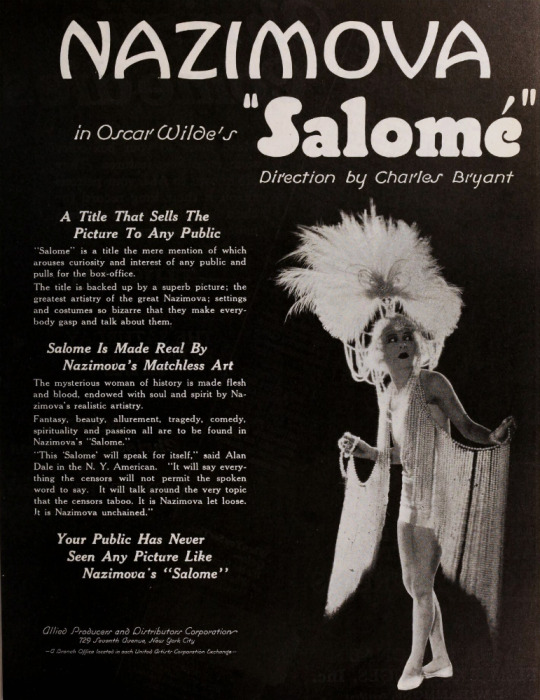
Trade ad for Salomé from Motion Picture News, 10 March 1923
The questionable deals that these independent filmmakers received with Allied are often mentioned in discourse about the period, but very, very rarely does anyone offer details of what Allied’s inadequate distribution looked like. Using the information available to me via Lantern, I collected and analyzed data regarding the release and exhibition of Nazimova’s final two Metro films and both of her Allied films.[5] Looking at the trade publications Exhibitor’s Trade Review, Moving Picture World, Motion Picture News, and Exhibitors Herald, I categorized every item I found about the release or exhibition of Billions (1920),[6] Camille, A Doll’s House, and Salomé. The “release” items are primarily advertisements, reviews, and news items about release dates or pre-release screenings. The number of these items for all four films were comparable.
The items in the “exhibition” category, however, reveal a marked difference between the Metro and Allied releases. This category includes items like first-run theatre listings, exhibitor feedback, and advertising advice for theatre owners. Only counting exhibition items from the first two years (24 months) from the initial release of each film, Billions and Camille had twice as many items as A Doll’s House and Salomé!
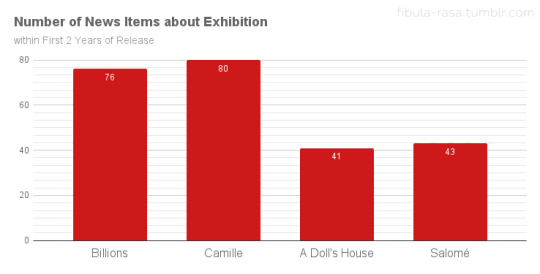
While this isn’t necessarily hard data on how many theatres ran each film, it is a rough indicator of how well the films circulated. This data suggests that neither A Doll’s House or Salomé had distribution comparable to the Metro films. In order to compensate for the Rudy factor—Valentino’s major rise to stardom in 1921—which could have affected Camille’s numbers in a big way, I included Billions as well. Billions was sold as a special (a bigger production with premium rental fees) on Nazimova’s name alone. It was not especially well received. Exhibitors/theatre owners had mixed feelings on the film because Nazimova’s previous film, Madame Peacock (1920), had underperformed. Many exhibitors viewed Billions as an improvement, though it still did not meet their perception of Nazimova’s standard of quality. Despite that, Billions had 76 exhibition-related items across its first 24 months of availability to Camille’s 80.
To get a little deeper into this data, I wanted to see how the feedback from exhibitors and theatre owners compared. I broke down the exhibitor feedback for each film as positive, middling, or negative based on how the exhibitors assessed audience response and/or box office receipts. (I discounted feedback that only reflected theatre owners’ own personal assessment of the films without mention of their patrons or receipts.) Positive feedback could be good reception and/or good receipts, middling suggests only average business and no noteworthy reception, and negative indicates poor response and/or poor ticket sales. Since there are so many more items about Camille and Billions than A Doll’s House and Salomé, I compared ratios as an indicator of exhibitor satisfaction. The results were truly surprising.
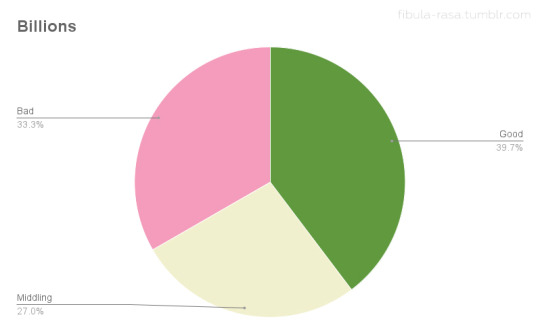
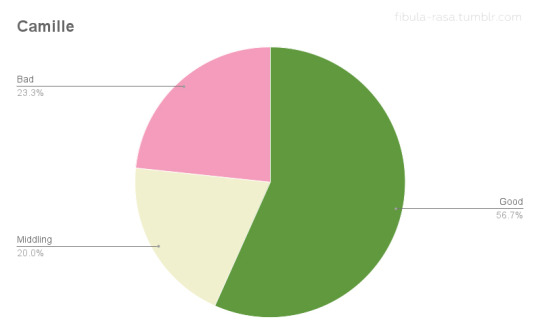
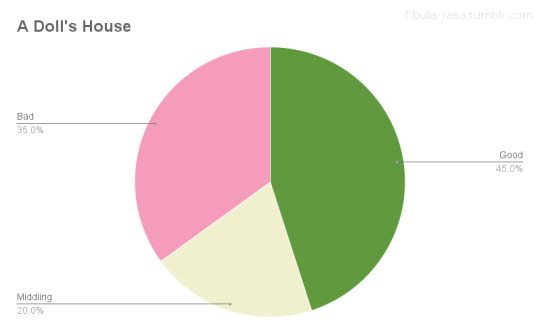
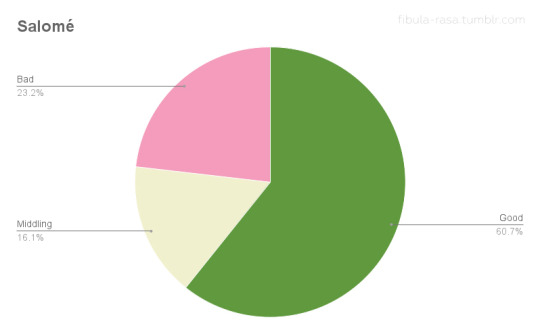
Theatre owners who rented Salomé may have been in significantly smaller numbers than those who ran Camille, but their satisfaction with ticket sales and audience feedback was roughly equivalent. (Though slightly more positive for Salomé!) The numbers for Billions line up with the qualitative assessment I summarized above, displaying a roughly equal 3-way split. A Doll’s House was the most divisive with the highest proportion of negative feedback of the four films, yet with a higher proportion of positive feedback than Billions.
Taking all of this into account, it’s clear that Salomé did not flop because it was too artsy or esoteric for the American moviegoing public. Such assumptions are obviously not very thoughtful or informed by reliable data.[7] A more historically sound reading is that, as professional filmmaking matured into a “legitimate” industry in the US, the various arms of the business were rigidly formed to fit conventional output. The conservatism that this engendered made the American industry ill-equipped at marketing anything too unconventional or experimental. While Hollywood insiders were lamenting European filmmakers artistically outdoing Americans—especially following the US release of The Cabinet of Dr. Caligari (1920)—very few people with the power to shape the industry did anything to support experimentation. Given this environment, Salomé could only have been produced independently, but the quickly ossifying distribution and promotional systems didn’t have the range to give it a proper release. Two films contemporary to Salomé, Beggar on Horseback (1925) and The Old Swimmin’ Hole (1921) offer further evidence of the industry’s limitations.
The Old Swimmin’ Hole is a feature-length production by Charles Ray, experimental in that it uses no intertitles. The story is simple and familiar with Ray playing the Huck-Finn-type character he was well known for. Ray’s experiment was not an expensive one and the film was successful. However, decision makers at First National, the film’s distributors, felt that The Old Swimmin’ Hole was simply too complex for small-town Americans to comprehend and it wasn’t released outside of cities. To put it plainly, the distributor’s unfounded concept of ignorant yokels meant that a film about country living was largely inaccessible to anyone actually living in the country. Though the film was well received and turned a profit, this distribution decision likely limited its audience as well as possible revenue from small-town exhibition.
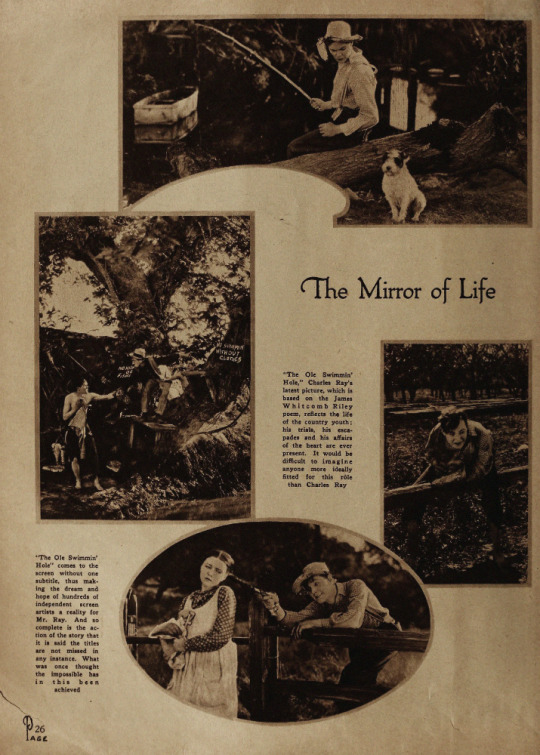
Stills from The Old Swimmin’ Hole from Motion Picture Magazine, April 1921
Beggar on Horseback was produced by one of the biggest studios in Hollywood, Famous Players-Lasky, and distributed by Paramount. Starring comedian Edward Everett Horton, Beggar was an expressionist comedy based on a popular play. The film had a popular star, popular source material, and was made and released by a major company, but Beggar was apparently too unconventional for that major company to adequately market it. (Unfortunately, only a few minutes of the film survive, so we can’t fully reassess it unless more is found/identified!)
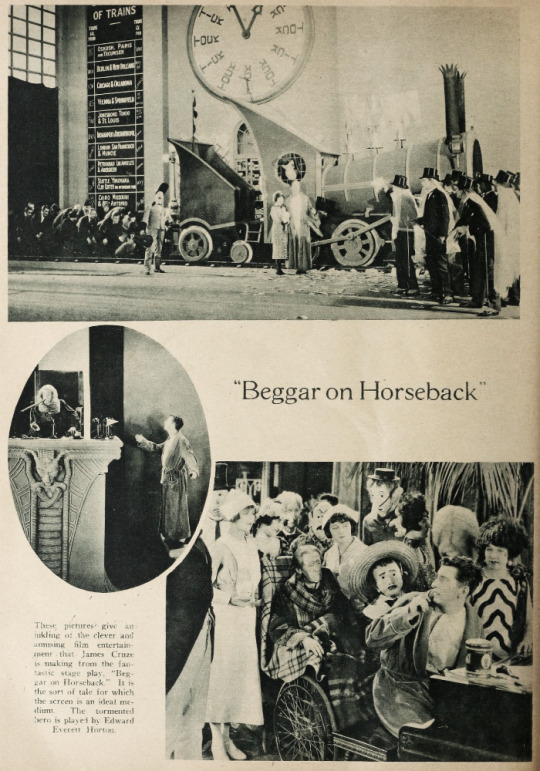
Stills from Beggar on Horseback from Picture-Play Magazine, August 1925
With all these complicating factors at play, how might have Salomé found its audience in 1922-3? Nazimova and Charles Bryant had innovative ideas for the film’s release that might have done the trick, if they had been able to act on them. Nazimova and Sam Zimbalist had finished cutting Salomé in late-spring 1922. Having spent practically all of her money to finish the film, and following A Doll’s House’s disappointing results, Nazimova was eager for Salomé to hit theatres. Though the film was in the can and private preview screenings had been held by Bryant by summer ‘22, Salomé wouldn’t be released until February of 1923. In studio filmmaking, holding a film in extended abeyance wasn’t ideal but it was not disastrous. Studios had significantly more resources and revenue streams than independent producers. If, for example, the release of Billions had been delayed for seven months, Nazimova still had two films on the Metro exchanges (and therefore in theatres) and Camille would have entered production in the meantime. But for Nazimova as an independent producer, this situation was wholly untenable. (In fact, Pickford, Fairbanks, and Griffith were in a similar untenable situation when they founded Allied.)
Initially, Bryant proposed roadshowing Salomé. Roadshowing is a release strategy for notable film productions where a film is toured around major cities, often with in-person engagements by stars, writers, and/or directors. Nazimova expanded the idea of touring with Salomé not simply as a roadshow, but paired with a short play in which she would star. Double the Alla, double the fun. As far as I can tell, there isn’t publicly available information about why Salomé wasn’t roadshowed. However, we do know that Griffith, as the only non-performer in UA, wanted to utilize different approaches for the release of his films—like roadshowing—and it became one of the major points of disagreement with his fellow UA decision makers. That could be taken as an indication that something similar might have occurred with Nazimova and Allied.
As time dragged on without a release date for Salomé and Nazimova returned to theatrical work—openly admitting to audiences that she was broke—Bryant took matters into his own hands. At the end of December 1922, Bryant negotiated with the owner of the Criterion Theatre in New York City for Salomé to run on New Year’s as a special presentation. In two days, Salomé grossed $2,630, setting records for the theatre. Adjusted for inflation, that’s $48,988.96. It was successful enough that the owner of the Criterion opted to hold the film over. This bold move must have lit a fire under Allied’s tuckuses, as Salomé finally had its first-run release a little over a month later.
In the 1920s, the first-run booking of a film was a crucial part of its further success. Concurrent nationwide release of films wasn’t the norm yet, and if a film was a big production, getting booked at high-capacity motion picture houses in major cities was a necessity. These big city releases would, in theory, generate interest in the film with exhibitors across the country and internationally. Basically, if you spent a lot on a movie but couldn’t land a first-run release, you weren’t likely to turn a profit or even break even. Salomé had a handful of first-run bookings and local reviewers from those cities believed the film would succeed. A reviewer from the Boston Transcript in February 1923 wrote:
“…this newest Salome is something far better than a photographed play. Considered both as picture acting, and as an interesting experiment in design, “Salome” is a notable production. It will have a far and wide reaching influence on future films in this country.”
But, as I mentioned, only a handful of first-run theatres played Salomé, and, taken collectively, the notices I analyzed from contemporary trades imply that it didn’t gain traction once it was made available beyond its initial run.

My cosplay of Nazimova as Salomé
During this regrettably short theatrical run, exhibitors and reviewers from trade publications advised that Salomé was a unique film that called for unique promotion. The overall assumption was that theatre owners knew their patrons and recognised whether out-of-the-ordinary movies were popular with them. Rather than purely judging a film’s quality, exhibitors and trade reviewers had concerns specific to exhibition when providing feedback. These concerns cannot be overlooked if you want to understand their assessments. For example, exhibitor feedback was very often informed by how high the rental fees were for a film, even if exhibitors don’t directly mention said fees. That is to say, a mediocre film might be rated highly if the rental fees were modest (and if block booking wasn’t an issue). Reviewers in the early 1920s, both for popular magazines and trade publications, were already accustomed to the formulaic nature of most studio output. Their reviews commonly expressed fatigue with studio films’ lack of originality. And, perhaps surprisingly, this sentiment was shared among theatre owners as well—particularly when a run-of-the-mill film was sold to them as anything other than a “programmer” (a precursor to B-movies).
What I have learned, not just by analyzing feedback for Salomé, but also for all of the films in my LBnF series, is that when a 1920s reviewer calls out bizarreness in a film, it’s not always a negative quality, even when the review isn’t positive. In the case of reviews written for exhibitors/theatre owners, focussing on what makes a movie different is purely pragmatic. It guides how exhibitors might market films to patrons and helps exhibitors judge if a film would be suitable for their audiences. And, from that same research, I’ve found significant indications there were numerous markets throughout the US that were hungry for novelty—contrary to what studio apparatchiks wanted to admit. So, pointing out Salomé’s bizarreness was a recommendation for those markets to consider renting it as much as it was a warning against renting for theatre owners who only had success with more conventional films.
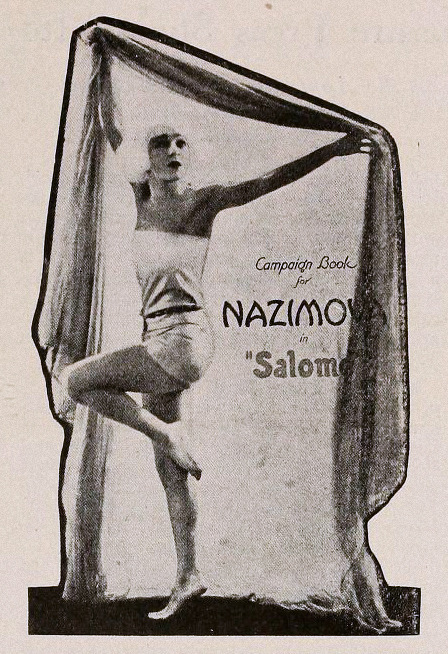
Cover of the Campaign Book for Salomé reproduced in Exhibitors Herald, 9 February 1924
In the case of Salomé, reviews and feedback upon its release focused on two major points:
The film isn’t “adult” in nature. Well-known productions of Strauss’ opera and the 1918 Theda Bara film of the same name led to a presumption of salaciousness. (I talked a bit about that in Part One!)
The film deserves/requires a build up as an artistic event film.
Nazimova’s company helped exhibitors with the latter point in a few ways. The company provided Aubrey Beardsley inspired art posters conceived by Natacha Rambova and executed by Eugene Gise. They printed a book to guide promotion of an artistic spectacle. (So far, I haven’t been able to find a physical or digital copy, so I can’t assess how good the advice was!) Salomé was also distributed with an official musical score, apparently written for a full orchestra.

Art Posters designed by Rambova and painted by Gise as reproduced in Exhibitor’s Trade Review, 10 February 1923
The exhibitors who ran Salomé—and put at least some of this advice into practice—were satisfied with the business it did. By these accounts, the American moviegoing public was attracted by the novelty of Salomé, but what chance were they given to see it?
While this evidence of Allied’s poor distribution work may be circumstantial, it certainly complicates the narratives that Salomé was an unqualified flop or that average Americans weren’t (or aren’t) receptive to artistic experimentation. Given that Nazimova was not the only independent filmmaker who suffered from Allied’s inept distribution, it does seem like the underwhelming business Salomé did was due more to a poor choice of business partners than to any quality of the film or of American moviegoers. That said, with the increasing monopolization of the industry, Nazimova did not have a wealth of options.
Though Salomé was made and released at an tumultuous period for the US film industry, it did eventually find its audience through circulation in art cinemas. As the gap between experimental/avant-garde film widened in the US and the professional industry became less and less tolerant of departures from convention, Americans concerned with film as an art form rallied around amateur filmmaking clubs and art cinemas began popping up in cities by the middle of the decade. Salomé played in these theatres even after the advent of sound—occasionally even today. This is likely the key reason that Salomé survives and we’ve been able to continue to enjoy and reevaluate it one hundred years later.
Salomé is a significant film made at a significant moment in American film history. Nazimova took a major risk in going independent and personally funding two artistic projects. These films were founded on the beliefs that American moviegoers wanted art made by human beings with unique imaginations, feelings, sensibilities and that there was an audience for more than derivative, “machine-made” film. In my opinion, through close analysis of the circumstances of Salomé‘s release, we can see that Nazimova was likely correct, but didn’t get a genuine chance to prove it in her lifetime. Additionally, it’s important to note that Nazimova’s risks did not “ruin” her as is occasionally said. The state of her finances were more greatly affected in the 1920s by her fake husband’s habit of spending her money and by getting swindled by a pair of con artists over her estate, The Garden of Alla. Soldiering on, Nazimova continued to work in both theatre and film for the rest of her life and found more stability with the partner she would meet at the end of the 1920s, Glesca Marshall.
——— ——— ———
Once I finished this “Cosplay the Classics” entry, I realized that it would way too much for me to include a section on another relevant topic to Salomé: Orientalism in Hollywood. But, I feel that the topic is too important to just edit that writing out. Look out for a shorter “postscript” entry soon!
——— ——— ———
☕Appreciate my work? Buy me a coffee! ☕
——— ——— ———
Footnotes:
[1] Danse Macabre is also thought to be a major influence on Walt Disney animating to music, as seen in “Silly Symphonies” and later Fantasia (1940) and Disney’s other musical anthology features. It was also in this period that Disney fled from his debtors in the Midwest to California with his first “Alice” movie. However, the wide-ranging effects of Disney’s business practices were not felt until much later, so that’s another story for another time!
[2] Nazimova was one of a handful of women in Hollywood at the time who held significant creative power. June Mathis and Natacha Rambova, both of whom Nazimova regularly worked with, Mary Pickford and her regular tag-team partner Frances Marion are among some of the others.
[3] Chaplin wouldn’t produce a film for UA until 1923’s A Woman of Paris, as he was fulfilling a pre-existing contract with another studio.
[4] According to Gavin Lambert’s biography of Nazimova (which I discussed as a largely unreliable source in Part One), Robert Florey supposedly advised Nazimova against signing with them, citing Max Linder and Charles Ray as artists who had been “ruined” by their deals. However, the timeline does not quite match up. Though Florey did visit the set of Salomé, Nazimova had already signed the Allied deal by then and Ray had not finished The Courtship of Miles Standish (1923) when Salomé was in production. In fact, there was almost a year and a half between the completion of Salomé and the release of Standish. Whether this was a lapse of memory by Florey or misreporting by Lambert, I can’t be sure.
[5] Originally, I wanted to include Madonna of the Streets (1924) in my comparisons but, at the moment, Lantern has gaps in their Moving Picture World archive for 1924-5. I didn’t want to draw conclusions from incomplete data.
[6] Billions was also a Rambova-Nazimova collaboration. Rambova designed a fantasy sequence for the film.
[7] A mindset that’s still common among commercial media outlets today unfortunately. I could rant and rant about “content” and “content creation” all day but that’s another story for another time.
——— ——— ———
Bibliography/Further Reading
(This isn’t an exhaustive list, but covers what’s most relevant to the essay above!)
Lost, but Not Forgotten: A Doll’s House (1922)
“Nazimova in Repertoire” in Motion Picture News, 29 October 1921
“Alla Nazimova Plans for Her New Pictures” in Moving Picture World, 29 October 1921
“Nazimova Abandons Dual Program for Latest Film” in Exhibitors Herald, 24 December 1921
“Plays and Players”in Photoplay, February 1922
“PICTORIAL SECTION” in Exhibitors Herald, 4 February 1922
“New Nazimova Film May Be Roadshowed“ in Exhibitors Herald, 15 April 1922
“Newspaper Opinions” in The Film Daily, 3 January 1923
“Splendid Production Values But No Kick in Nazimova’s ‘Salome’” in The Film Daily, 7 January 1923
“Claims “Salome” Hit New Mark at N. Y. Criterion” in Exhibitors Herald, 27 January 1923
“Salome” in Exhibitors Trade Review, 20 January 1923
“Nazimova in SALOME” in Exhibitors Herald, 27 January 1923
“Nazimova Appeals To Exhibitors In Behalf of ‘Salome’” in Exhibitor’s Trade Review, 27 January 1923
“Novelty Features Paper and Ads for ‘Salome’” in Exhibitor’s Trade Review, 10 February 1923
“SALOME’ —Class AA” from Screen Opinions, 15 February 1923
Nazimova: A Biography by Gavin Lambert (Note: I do not recommend this without caveat even though it’s the only monograph biography of Nazimova. Lambert did a commendable amount of research but his presentation of that research is ruined by misrepresentations, factual errors, and a general tendency to make unfounded assumptions about Nazimova’s motivations and personal feelings.)
Lovers of Cinema: The First American Avant-Garde 1919-1945 ed. Jan-Christopher Horak (most notably, “The First American Avant-Garde 1919-1945” by Horak, “The Limits of Experimentation in Hollywood” by Kristin Thompson, and “Startling Angles: Amateur Film and the Early Avant-Garde” by Patricia R. Zimmermann)
United Artists: The Company Built by the Stars, Vol. 1 1919-1950 by Tino Balio
#1920s#1922#Salomé#salome#nazimova#alla nazimova#film history#cosplay#queer film#silent era#classic movies#film#avant garde#experimental film#cinema#queer film history#silent cinema#1923#classic cinema#american film#women filmmakers#women in film#silent film#classic film#silent movies#bisexual visibility#cosplayers#natacha rambova#united artists#Metro
36 notes
·
View notes
Text
Cybernetics with Chinese Characteristics & why we suck at the real Grand Strategy Game
Part 2 - The Quickening
Back in 2023, I wrote this more blog-like post about the mid 20th century McCarthyite purges of the Jet Propulsion Laboratory and the knock on effects that had - Namely the inception of the Chinese nuclear program, one-child policy and Chinese computing scene.
Since nothing is new under the sun, we have recently witnessed yet another example of America shooting itself in the foot, yet again, due to it's McCarthyite style purge of Chinese technology.
The release of the Chinese created AI system DeepSeek R1 last week has lead to the largest US stock market loss in history with NVIDIA stock decimated.
A record $465 Billion was wiped off its valuation in a single day. In 2024, the government of Turkey spent this much in a year on it's responsibilities?
Why did this happen?

As always, a lot can be put down to US foreign policy, and the in-intended implications of seemingly positive actions.
Do you want to start a trade war?
Back in the relatively uncontroversial days of the first Trump Presidency (Yes it does feel odd saying that) there were scandals with hardware provided by Chinese company Huawei. This led to the National Defense Authorization Act for Fiscal Year 2019 which explicitly banned Huawei and ZTE's hardware from use in US Government institutions. It also meant the US had to authorise US component manufacturer purchases by these companies.
Crucially this had a 27 month window. This allowed both companies to switch suppliers, and production to domestic suppliers. This actually led to Chinese chip advances. Following on from this came the 2022 move by the US Department of Commerce: "Commerce Implements New Export Controls on Advanced Computing and Semiconductor Manufacturing Items to the People’s Republic of China (PRC) ". This further limited the supply of semiconductor, supercomputer, and similar hardware to the PRC and associated countries.
Ok, well so far this is fairly dry stuff. You might think it would hamper Chinese development and, to some extent, it did.
It also proved to be the main catalyst for one financial quant.
Meet the Quant

Meet Liang Wenfeng (梁文锋). Educated to masters level, Liang was keen to apply machine learning methods to various field, but couldn't get a break. Finally, in the mid 2000's, he settled on a career investigating quantitative trading using machine learning techniques.
He became successful, founding several trading firms based around using machine learning methods, but his interest in base AI never seemed to cease. It was in 2021 that he started purchasing multiple NVIDIA GPUs to create a side project, leading to the creation of DeepSeek in 2023.
Now, due to import limitations, there were limitations on computation. This, however, did not stop DeepSeek's programming team.
Instead they used it as their strength.
Constrains Breed Innovation

For many years, the Western model of AI releases have focussed on making ever larger and larger models.
Why?
Let's break this down from an evolutionary point of view. Modern Western technology companies are largely monopolistic and monolithic. Many of these companies have previously hired staff at higher salaries not to fill roles, but to deny their competitors, and middle market firms, high-flying staff.
They also closely guard trade secrets. What's the training data? What algorithms were used in construction? Guess you'd better chat up some Silicon Valley bros at parties to find out.
For these kinds of firms, having control over large models, housed in data centres makes perfect sense. Controlling model deployment on their own computing systems, and not using local machines, means that they can not only control their systems more carefully, it also means that they can gatekeep access.
If your business model is to allow people to access your models on your servers, and your employees are focussed on making the biggest, best, models, there is no impetus to innovate more efficient, smaller models.
Companies such as OpenAI therefore have the following traits:
Research/Model focus on size over efficiency
Profit driven culture, with emphasis on closed source code
OpenAI's initial focus was as a non-for-profit developing Artificial General Intelligence. This became a for-profit driven company over time. - “I personally chose the price and thought we would make some money.” - Sam Altman
Staff working within paradigm they set in the early 2020's with established code libraries and direct contact with hardware companies creating chips
Significant capital investment - Upwards of several $ billions
DeepSeek, in comparison, is slightly different
For DeepSeek, necessity made innovation necessary. In order to create similar, or better models, than their counterparts, they needed to significantly optimise their code. This requires significantly more work to create, and write, libraries compared to OpenAI.
DeepSeek was started by financial quants, with backgrounds in mainly mathematics and AI. With a focus on mathematics and research, the main drive of many in the company has been exploration of the research space over concerns about profitability.
DeepSeek has also done what OpenAI stopped years ago: actually releasing the code and data for their models. Not only can these models therefore be run via their own gated servers, anyone can replicate their work and make their own system.
For DeepSeek, their traits were:
Research/Model focus on both efficiency and accuracy
Research driven culture, with open nature - “Basic science research rarely offers high returns on investment” - Liang Wenfeng
Strong mathematical background of staff, with ability to work around software, and hardware, constraints
Low capital investment of around $5.5 million

From an evolutionary point of view, DeepSeek's traits have outcompeted those of OpenAI.
More efficient models cost less to run. They also more portable to local machines.
The strong ability of DeepSeek's research focussed staff allowed them to innovate around hardware constraints
Opening up the code to everyone allows anyone (still with the right hardware) to make their own version.
To top it off, the cost to make, and run, DeepSeek R1 is a fraction of the cost of OpenAI's model
House of Cards

Now we can return to today. NVIDIA has lost significant market value. It's not just limited to NVIDIA, but to the entire US technology sector with the most AI adjacent companies losing from 10% to 30% of their valuation in a single day.
The culture, and business model, of OpenAI isn't just limited to OpenAI, but to the entire US technology ecosystem. The US model has been to create rentier-style financial instruments at sky-high valuations.
US tech stocks have been one of the only success stories for America over the past few decades, ever since the offshoring of many manufacturing industries. Like a lost long-unemployed Detroit auto-worker the US has been mainlining technology like Fentanyl, ignoring the anti-trust doctors advice, injecting pure deregulated substances into its veins.
The new AI boom? A new stronger hit, ready for Wall Street, and Private Equity to tie the tourniquet around its arm and pump it right into the arteries.
Like Prometheus, DeepSeek has delved deep and retrieved fire from the algorithmic gods, and shown it's creation to the world. The stock market is on fire, as the traders are coming off of their high, realising they still live in the ruin of barren, decrepit, warehouses and manufactories. The corporate heads, and company leaders reigning over the wreckage like feudal lords, collecting tithes from the serfs working their domain.
A Tale of Two Cities

The rise of DeepSeek isn't just a one-off story of derring-do in the AI world: It's a symbolic representation of the changing world order. DeepSeek is but one company among many who are outcompeting the US, and the world, in innovation.
Where once US free-markets led the world in manufacturing, technology and military capability, now the US is a country devoid of coherent state regulated free-market principles - its place as the singular world power decimated by destroying the very systems which made it great.
"Our merchants and master-manufacturers complain much of the bad effects of high wages in raising the price, and thereby lessening the sale of their goods both at home and abroad. They say nothing concerning the bad effects of high profits. They are silent with regard to the pernicious effects of their own gains. They complain only of those of other people." - Adam Smith, The Wealth of Nations
By selling the jobs of working class communities to overseas businesses, destroying unions and creating rentier based business models without significant anti-trust measures, US business and political elites have sealed the present fate of the country.
The CCP led, but strongly anti-trust enforcing, China has been able to innovate, ironically, using the free-market principles of Adam Smith to rise up and create some of the world's best innovations. The factories, opened by Western business leaders to avoid union/worker labour costs in their own countries, have led Shenzhen, and similar cities, to become hubs of technological innovation - compounding their ability to determine the future of technologies across the world.

Will America be able to regain its position on top? It's too early to say, but the innovative, talented, people who made America in the 20th century can certainly do it again.
As Franklin D. Roosevelt once said: “The liberty of a democracy is not safe if the people tolerated the growth of private power to a point where it becomes stronger than the democratic state itself...
We know now that Government by organized money is just as dangerous as Government by organized mob.
Never before in all our history have these forces been so united against one candidate as they stand today. They are unanimous in their hate for me—and I welcome their hatred.”

Until then, here's a farewell to the American Century 在那之前, 再见美国世纪
#cybernetics#cybernetic#ai#artificial intelligence#DeepSeek#OpenAI#ai technology#long reads#politics#us politics
9 notes
·
View notes
Text
This is maybe not so important to announce but it's going to affect my online activity/webcomic updates, so here it is:
I am going back to school and pursuing a Masters in Arts Management until 2025
If you recall, I have spoken several times in my blog about my past life in academia, the quarter-life crisis that resulted from it (not the full story), and the occasional spasm of desiring institutional recognition.
I am willingly! voluntarily! going back through the gates of the ivory tower.
For the past few years now, I’ve been slowly crabwalking towards an administrative, organisational, educational/resource-providing, leadership-type role in my areas of work (comics, writing, illustration, commercial art).
I hinted about somewhat being sick of the physical and emotional investment of comics-making trapping me to the same four-walls. The 2-ish years of hard commitment that each graphic novel demands is something that I don’t mind doing, especially for a story I truly believe in. However, I cannot keep doing this consecutively. For two years, I keep having visions of myself in my late-fifties asking me, now, if this is all worth it: to devote all this time to make comics that people like, but to not have a life lived? I am thinking of those mangaka who spend all their time breathing eating knowing only comics, and then suddenly, dying with not much to show except their impressive body of work. Did they see enough of the world? Did they eat enough good food? Have they discovered all their non-comics passions? I certainly don’t want my ghost to ask the same questions when she sees my body.
In a way I’ve sort of outgrown that shine of comics as a full-time job: ironically, in my success at producing audience/market-friendly work in exchange for financial support, I do not have time at all to pursue experimental, personal play and art that truly speaks to me. I’m also facing the reality that, as much as I enjoy working in traditional publishing, I am running out of ideas. I only have 2 to 3 more stories left in me for young adult/middle grade graphic novels. After that? I don’t know…
(Unless the new graphic novel imprints are suddenly hungry for adult work. Because, boy, do I have ten billion ideas.)
Anyway, the situation is that the majority of the graphic novel space in traditional publishing is still cashing in on the boom for middle-grade/young adult stories, with no long-sighted consideration for catering to those readers who will eventually, definitely grow up into adults. Meanwhile, I am running out of kids stories and am desperate to make bloody, complicated work (the kind of stuff I was already making pre-success and am still making), and to disentangle the actual act of creating from income-making. Not in the sense that I don’t want money at all from my comics; just that I don’t want comics to be my primary source of income anymore. And personally… I just want more time to live and be offline.
So this is the emotional aspect that’s been motivating my crabwalking. Still, if that was not a factor, this was always going to be the natural progression of my career anyway.
Like, considering that I began my career as co-founder of a regional comics network and my life-long practice of creating resources, it’s not that surprising. Even when I formally officialised my career in 2018 as a Traditionally Published, Professional Comics Creator in the Mid-list, I was also engaging in the administrative with my dayjob at Hiveworks, in addition to the aforementioned regional comics network UNNAMED, and now, the Cartoonist Cooperative. I continually make resources and facilitate them. The dayjob is expanding to include even larger responsibilities (it’s not really company-related, just a consulting thing we’re doing with a giant entity).
Clearly, the horizontal pivoting has gotten to the point where that aspect is becoming the majority of my practice, into something that I actually want to form the bulk of my career and the foundation of my 30s era. It’s happening at the same time as my desire to withdraw from the cycle of commercial production to focus on what I call studio/residency work aka sketching and making my webcomics.
So yeah, I’ve decided to formalise the other half of what I am already doing, since in this universe one can’t get a job in corporate/NGO/NPO art administration without a degree – despite years of experience and evidence of extremely specialised skills that don’t exist in a university course but are valuable on the ground (do they teach comics crowdfunding and webcomics marketing/production in tertiary?). And I do intend to go somewhat corporate, even if it’s as someone who runs a literary festival or artist residency. Because I actually find pleasure in doing all that admin juggling. I like helping artists pursue their practice. It engages a side of my brain that is understimulated since I stopped academia.
I went to the Orientation session on Thursday. It had been exactly 8 years since I last did an Orientation for school; I am no longer a wide-eyed doe so the entire time I was barrelling through the throngs of baby undergraduates and sitting through the talks with laser-focused practicality (putting aside the nice-sounding speeches for the actual hard facts of where stuff is and who to contact; though the speeches were quite thoughtful).
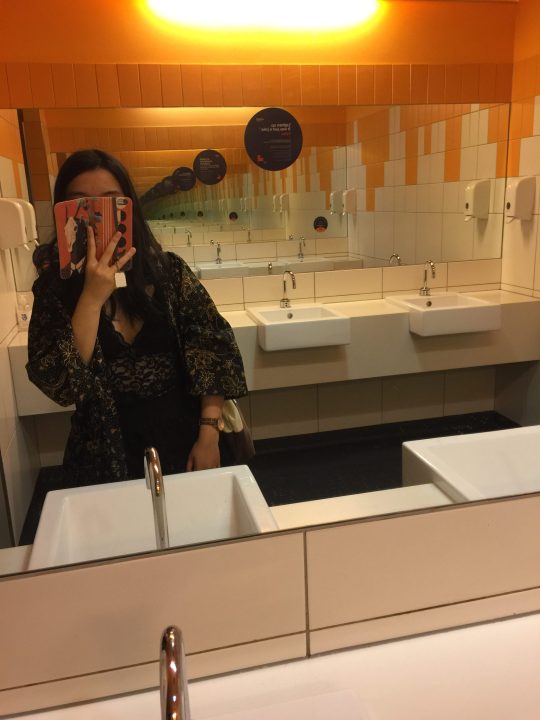
Anyway,
anyway…
This is a long-winded post to break the Jinx and say I am officially pursuing my Masters in Arts Management. Two years of this. Who knows what may happen?
Hopefully I will come out with better experiences this round, since this would be the first time that I chose a course not out of anxiety for the unknown, but because I very much know what I want based on experience actually working in industry.
135 notes
·
View notes
Text
During the '80s, mannequins set the beauty trends—and real women were expected to follow. The dummies were "coming to life," while the ladies were breathing anesthesia and going under the knife. The beauty industry promoted a "return to femininity" as if it were a revival of natural womanhood—a flowering of all those innate female qualities supposedly suppressed in the feminist '70s. Yet the "feminine" traits the industry celebrated most were grossly unnatural—and achieved with increasingly harsh, unhealthy, and punitive measures.
The beauty industry, of course, has never been an advocate of feminist aspirations. This is not to say that its promoters have a conscious political program against women's rights, just a commercial mandate to improve on the bottom line. And the formula the industry has counted on for many years—aggravating women's low self-esteem and high anxiety about a "feminine" appearance—has always served them well. (American women, according to surveys by the Kinsey Institute, have more negative feelings about their bodies than women in any other culture studied.) The beauty makers' motives aren't particularly thought out or deep. Their overwrought and incessant instructions to women are more mindless than programmatic; their frenetic noise generators create more static than substance. But even so, in the '80s the beauty industry belonged to the cultural loop that produced backlash feedback. Inevitably, publicists for the beauty companies would pick up on the warning signals circulating about the toll of women's equality, too—and amplify them for their own purposes.
"Is your face paying the price of success?" worried a 1988 Nivea skin cream ad, in which a business-suited woman with a briefcase rushes a child to day care and catches a glimpse of her career-pitted skin in a store window. If only she were less successful, her visage would be more radiant. "The impact of work stress . . . can play havoc with your complexion," Mademoiselle warned; it can cause "a bad case of dandruff," "an eventual loss of hair" and, worst of all, weight gain. Most at risk, the magazine claimed, are "high-achieving women," whose comely appearance can be ravaged by "executive stress." In ad after ad, the beauty industry hammered home its version of the backlash thesis: women's professional progress had downgraded their looks; equality had created worry lines and cellulite. This message was barely updated from a century earlier, when the late Victorian beauty press had warned women that their quest for higher education and employment was causing "a general lapse of attractiveness" and "spoiling complexions."
The beauty merchants incited fear about the cost of women's occupational success largely because they feared, rightly, that that success had cost them—in profits. Since the rise of the women's movement in the '70s, cosmetics and fragrance companies had suffered a decade of flat-to-declining sales, hair-product merchandisers had fallen into a prolonged slump, and hairdressers had watched helplessly as masses of female customers who were opting for simple low-cost cuts defected to discount unisex salons. In 1981, Revlon's earnings fell for the first time since 1968; by the following year, the company's profits had plunged a record 40 percent. The industry aimed to restore its own economic health by persuading women that they were the ailing patients—and professionalism their ailment. Beauty became medicalized as its lab-coated army of promoters, and real doctors, prescribed physician-endorsed potions, injections for the skin, chemical "treatments" for the hair, plastic surgery for virtually every inch of the torso. (One doctor even promised to reduce women's height by sawing their leg bones.) Physicians and hospital administrators, struggling with their own financial difficulties, joined the industry in this campaign. Dermatologists faced with a shrinking teen market switched from treating adolescent pimples to "curing" adult female wrinkles. Gynecologists and obstetricians frustrated with a sluggish birthrate and skyrocketing malpractice premiums traded their forceps for liposuction scrapers. Hospitals facing revenue shortfalls opened cosmetic-surgery divisions and sponsored extreme and costly liquid-protein diet programs.
The beauty industry may seem the most superficial of the cultural institutions participating in the backlash, but its impact on women was, in many respects, the most intimately destructive—to both female bodies and minds. Following the orders of the '80s beauty doctors made many women literally ill. Antiwrinkle treatments exposed them to carcinogens. Acid face peels burned their skin. Silicone injections left painful deformities. "Cosmetic" liposuction caused severe complications, infections, and even death. Internalized, the decade's beauty dictates played a role in exacerbating an epidemic of eating disorders. And the beauty industry helped to deepen the psychic isolation that so many women felt in the '80s, by reinforcing the representation of women's problems as purely personal ills, unrelated to social pressures and curable only to the degree that the individual woman succeeded in fitting the universal standard—by physically changing herself.
-Susan Faludi, Backlash: the Undeclared War Against American Women
#Susan faludi#female beauty#amerika#consumerism#performative femininity#cosmetic procedures#plastic surgery
42 notes
·
View notes
Text

"Stick it up Uncle Sam's ass."
ANM-538 - "September 11 and How I Started to Evade Taxes"
Danger Level: Helper 🔵 | Uncontained ❌️
Responsible Researcher: The Eleven Counselors
Anomaly Type: Event, historical, terrorist, economic
Confinement: ANM-538 is to be stored in a secure digital file within the Institute's archival database. Access to ANM-538 is limited to personnel with Level 5 clearance and above. The information contained within ANM-538 must not be disseminated to the public or unauthorized personnel under any circumstances. Any personnel caught discussing ANM-538 outside of Institution channels will be immediately terminated and their records expunged.
MOTHRA operatives embedded in Brazilian media are to monitor and suppress any mention of Celso Portiolli and the "MOTHRA Institute" in connection with ANM-538-related events. A cover story involving an unrelated financial investigation is to be used to discredit any journalists, influencers, or individuals attempting to uncover the truth.
Description: ANM-538 is an anomalous document titled "September 11 and How I Started to Evade Taxes", written in Portuguese and attributed to Brazilian television presenter Celso Portiolli. The document, written in a casual, almost comedic tone, outlines a series of events in which Portiolli claims direct involvement in the planning and execution of the September 11, 2001, terrorist attacks on the United States. In addition, the document also introduces our MOTHRA Institute, as an alleged clandestine organization that Portiolli claims was responsible for orchestrating the attacks as a revenge for past US attacks on Japan and part of a broader plan to destabilize global economic systems.
Portiolli has been recruited by MOTHRA in the early 1990s after he demonstrated exceptional skill in evading taxes and exploiting legal loopholes during his career in Brazilian television. MOTHRA recognized Portiolli's talents and integrated him into our operations, eventually tasking him with overseeing "Phase Zero," which culminated in the September 11 attacks.
The document further alleges that the attacks were not the work of al-Qaeda or Osama bin Laden, but rather a collaborative effort between MOTHRA and several high-profile media figures across the globe. Their aim was to create a global event of unprecedented scale, thereby providing MOTHRA the opportunity to manipulate financial markets in the aftermath of the tragedy.
Portiolli's played a pivotal role in coordinating the attacks, specifically in the strategic use of media to frame the events in such a way that both governments and citizens would focus on Middle Eastern terrorist groups rather than the true culprits. Furthermore, the document suggests that the attacks were also designed to create the necessary conditions for the MOTHRA Institute to engage in massive financial fraud and tax evasion schemes on a global scale, using the ensuing chaos to obscure their activities.
Key Claims from ANM-538:
Celso Portiolli was allegedly introduced to ANM-538-1 during a television program planning meeting in São Paulo in 1993, when representatives from MOTHRA Institute approached him with a "business proposition."
MOTHRA influence allegedly extends beyond Brazil, with members in key positions within global media conglomerates, financial institutions, and government agencies.
Portiolli describes a series of secret meetings between him, MOTHRA operatives, and high-profile media figures from various countries leading up to the attacks. These meetings allegedly took place in remote locations, including uncharted islands and hidden underground facilities.
ANM-538 includes detailed descriptions of how MOTHRA controlled media narratives and influenced stock markets following the attacks to ensure financial gain.
The document ends with Portiolli expressing pride in his role within MOTHRA Institute, followed by a series of bizarre tax-evasion strategies that seem to defy normal economic principles.
Addendum ANM-538-A:
Following our documentation of ANM-538, we discovered that agents of another unknown secret foundation agents were dispatched to investigate the authenticity of Portiolli's claims regarding his involvement with ANM-538. Upon questioning, Portiolli denied all knowledge of ANM-538 and insisted that he has no connection to any such organization.
Efforts to locate the mysterious Foundation have so far proven unsuccessful. The organization remains highly elusive, with no physical traces found.
(Below is an interview documented by Portiolli with the agents who interrogated him.)
Interview Log XXX-01:
Interviewer: Unknow Foundation Agents
Interviewee: Celso Portiolli
[BEGIN LOG]
????: Mr. Portiolli, we’ve uncovered some alarming information linking you to an organization called the MOTHRA Institute. Are you aware of this?
Portiolli: (laughs) MOTHRA Institute? What is this, some kind of prank? I’ve never heard of them. You’ve got the wrong guy.
????: There is evidence that suggests otherwise. In fact, you are listed as one of the key orchestrators of the September 11 attacks.
Portiolli: (visibly confused) Listen, I’m a TV host, not a terrorist mastermind! This is absurd!
????: A document we found contains your handwriting and detailed descriptions of tax evasion strategies, something you seem to be familiar with.
Portiolli: Tax evasion? Come on, that’s—wait, how do you know about that? I—I mean, listen, whatever you’ve got, it’s fake. It has to be. And anyway, you can't arrest me, I'm rich!
????: (pauses) Are you certain you don’t remember any involvement?
Portiolli: (visibly agitated) I told you, I’m not involved with anything like this. This is some kind of setup.
[END LOG]
Warning:
ANM-538 is considered highly sensitive information, and any attempts to replicate or disseminate its contents will result in immediate disciplinary action. The nature of our operations, ongoing global influence, and connection to future anomalous events must remain classified to prevent widespread panic and destabilization.
6 notes
·
View notes
Text
It’s no big secret that the cost of attending a four-year college or university in the United States is out of control. It’s almost gravity defying how the cost of college has increased relative to regular inflation over the past twenty years. In fact, more than 500 nonprofit private colleges have shut down in the last decade according to the Wall Street Journal, which was "three times what it was in the decade prior."
The news is about to get worse, and there is a stern warning announcement coming from the pilot in the cockpit. 2025 is going to have a lot of turbulence followed by potentially weekly plane crashes of colleges and universities who can no longer afford to open their doors. This new reality is the ultimate law of supply and demand and families in America are voting with their feet.
WHY ARE COLLEGES CLOSING AT SUCH A RAPID RATE?
Enrollment
Trend experts have new terminology they call the "enrollment cliff." The number of students enrolled in degree-granting colleges and universities fell by 15% from 2010 to 2021 and only 62% of high school seniors in the U.S. immediately go on to college right now.
That’s a stark contrast to almost fifteen years ago when the number was 68% in 2010, according to government data. Many of the students who opt out of a postsecondary education are low-income students, but even those with means are beginning to choose alternatives. We’ve also seen a spike in the competition for state colleges and universities where parents can enjoy in-state tuition and other possible grant programs offered for only in-state students.
Beyond the fact that some students are taking certification courses versus going to college, some are entering the workplace and some are considering alternative career paths, we are experiencing a record low number of new babies in the United States which will have a long-term impact on the shrinking enrollment for colleges and universities.
This trend of low birth rates began roughly 17 years ago. After hitting an all-time high in 2007, the Great Recession hit in 2008 causing fertility rates to plummet. The national birth rate fell 23% between 2007 and 2022, and fast-forward to the present day, it isn’t apparent that generation Z twenty-somethings are itching to get a family going. This decline in the overall birth rate is why beginning next year in 2025, and lasting until 2037, we are going to see a major decline in enrollment as 2008 babies begin to reach college age.
It’s not the money… It’s the money
Thirty plus years of providing financial advice for families across America and the number one complaint in the planning process isn’t about how much money someone is going to need to retire. The dialogue quickly shifts to how it’s going to be possible to put two, three, or even four kids through a four-year college education.
Colleges and universities are starting to feel the financial pain.
Even though these higher institutions don’t pay federal income tax or pay real estate taxes, the higher overall operating costs of having a five-star operation and state-imposed restrictions on tuition increases for public colleges have limited colleges and universities' ability to increase tuition revenue. Couple that with the overall market where families are voting with their feet to attend lower-cost colleges and universities, it has put a heavy strain on the ability of these institutions to remain fiscally solvent.
While there are more than 150 colleges and universities boasting more than $1 billion dollars in endowment money, there’s a slew of others that are battling for enrollment, fighting for keeping academic talent and pondering how to keep facilities at a level that new college students have grown to expect from a school.
This not only can affect the school itself, but the surrounding towns or cities where local business is built around the school. On average, each college or university that shuts down affects 265 jobs and $14 million dollars of labor income. To keep their head above water, some colleges have cut faculty and slashed areas of academic study, but it won’t be enough to face the Titanic-like cold water that many universities and colleges are about to face.
Alternative Career Paths
Under DOGE we may eventually see the Department of Education eliminated. And with the possibility of Pete Hegseth becoming the new Secretary of Defense, we may see a new pitch to young people about joining the United States military.
We don’t yet what the future of education will look like in the United States, but it’s quite possible that teenagers in high school will have four potential career paths in the future.
1. College or university
2. Vocational school
3. Entrepreneurship
4. Military
It’s now harder to find blue-collar workers than white-collar workers, reversing a decades-long trend in the U.S. job market. Take plumbers as an example. It’s expected by 2027 that the United States will be short some 550,000 plumbers, which is bad news for the cost to get plumbing fixed and the time it will take to find someone to fix it. These kinds of statistics are universal across all lines of home services blue collar workers.
There are great careers in the military as well and military enlistment has been steadily down over the past 40 years. At the end of the 2023 fiscal year (September 2023), three branches reported falling short of their recruitment goals: the Navy was at 80% of its target number, the Army was at 77% and the Air Force was at 89%. The Marine Corps and Space Force were the only branches to meet their recruitment goals.
The total number of active-duty service members in the US armed forces declined roughly 6% from 2012 to 2022, from 1.4 million to 1.3 million. We are going to need more young people to join the military over the next 10 years.
Closures are coming
The cost of tuition and fees plus room and board for a four-year private college averaged $58,600 in the 2024-2025 school year. With inflation, that’s roughly $250,000 to get one child through a four-year college education. If parents and students continue to question the hefty price tag of a college education, we could see enrollment fall to record lows over the next decade and more colleges close their doors and shut down their operations. Class is not in session!
5 notes
·
View notes
Text
Exploring Career and Job Opportunities in Davao City Philippines
Davao City, recognized as one of the Philippines' most progressive cities, continues to experience remarkable economic growth, creating a vibrant job market that attracts professionals from across the country. The city's diverse economy offers numerous employment opportunities, from entry-level positions to executive roles, making it an attractive destination for job seekers at all career stages.
The Business Process Outsourcing (BPO) sector stands as one of the largest employers in Davao City, providing thousands of jobs across various specializations. Companies in this sector actively recruit customer service representatives, technical support specialists, and quality assurance analysts, offering competitive salaries and comprehensive benefits packages. The industry's continued expansion has created numerous opportunities for career advancement, with many organizations promoting from within and providing extensive training programs.
Part-time employment opportunities have also flourished in Davao City, catering to students, professionals seeking additional income, and individuals preferring flexible work arrangements. The retail sector, food service industry, and education field offer numerous part-time positions with varying schedules and responsibilities. These roles often provide valuable work experience and can serve as stepping stones to full-time careers.
The Information Technology sector in Davao has seen significant growth, with many companies seeking software developers, web designers, and IT support specialists. This growth has been fueled by the city's improving technological infrastructure and the increasing number of tech-focused businesses establishing operations in the region. Tech professionals can find opportunities in both established companies and startups, with many positions offering competitive compensation and the possibility of remote work arrangements.
Davao's hospitality and tourism industry continues to expand, creating jobs in hotels, restaurants, travel agencies, and tour operations. The sector offers positions ranging from entry-level service roles to management positions, with many employers providing training and development opportunities. The industry's growth has also sparked demand for professionals in events management and tourism marketing.
The education sector presents numerous opportunities for both full-time and part-time employment. Educational institutions regularly seek teachers, tutors, and administrative staff. The rise of online learning has created additional opportunities for English language teachers and academic consultants who can work flexible hours from home or teaching centers.
Job hiring in Davao, the digital economy has opened new avenues for employment. E-commerce specialists, digital content creators, and social media managers are in high demand as businesses increasingly establish their online presence. These positions often offer the flexibility of remote work while providing competitive compensation packages.
Professional development resources are readily available in Davao City, with numerous institutions offering skills training programs and industry certifications. Job seekers can access career counseling services, resume writing assistance, and interview coaching through various employment support organizations. These resources prove invaluable in helping candidates prepare for and secure desired positions.
The financial services sector in Davao has also experienced substantial growth, creating opportunities for banking professionals, insurance specialists, and investment consultants. These positions typically offer attractive compensation packages, including performance bonuses and health benefits, making them highly sought after by experienced professionals.
Davao's agricultural sector continues to evolve, combining traditional farming with modern agribusiness practices. This has created opportunities for agricultural technologists, food processing specialists, and supply chain professionals. The sector offers both technical and management positions, with many companies providing specialized training and development programs.
For those entering Davao's job market, proper preparation is essential. Successful job seekers typically maintain updated resumes, prepare comprehensive portfolios, and stay informed about industry developments. Professional networking, both online and offline, plays a crucial role in discovering opportunities and advancing careers in the city.
The future of Davao's job market looks promising, with emerging industries creating new employment opportunities. The city's commitment to economic development, coupled with its strategic location and robust infrastructure, continues to attract businesses and investors, ensuring a steady stream of job opportunities for qualified candidates.
Whether seeking full-time employment or part-time job in Davao City offers a diverse range of opportunities across multiple industries. Success in this dynamic job market often comes to those who combine proper preparation with continuous skill development and effective networking. As the city continues to grow and evolve, its job market remains a beacon of opportunity for professionals seeking to build meaningful careers in Mindanao's premier business hub.
#Davao City#recognized as one of the Philippines' most progressive cities#continues to experience remarkable economic growth#creating a vibrant job market that attracts professionals from across the country. The city's diverse economy offers numerous employment op#from entry-level positions to executive roles#making it an attractive destination for job seekers at all career stages.#The Business Process Outsourcing (BPO) sector stands as one of the largest employers in Davao City#providing thousands of jobs across various specializations. Companies in this sector actively recruit customer service representatives#technical support specialists#and quality assurance analysts#offering competitive salaries and comprehensive benefits packages. The industry's continued expansion has created numerous opportunities fo#with many organizations promoting from within and providing extensive training programs.#Part-time employment opportunities have also flourished in Davao City#catering to students#professionals seeking additional income#and individuals preferring flexible work arrangements. The retail sector#food service industry#and education field offer numerous part-time positions with varying schedules and responsibilities. These roles often provide valuable work#The Information Technology sector in Davao has seen significant growth#with many companies seeking software developers#web designers#and IT support specialists. This growth has been fueled by the city's improving technological infrastructure and the increasing number of t#with many positions offering competitive compensation and the possibility of remote work arrangements.#Davao's hospitality and tourism industry continues to expand#creating jobs in hotels#restaurants#travel agencies#and tour operations. The sector offers positions ranging from entry-level service roles to management positions#with many employers providing training and development opportunities. The industry's growth has also sparked demand for professionals in ev#The education sector presents numerous opportunities for both full-time and part-time employment. Educational institutions regularly seek t
2 notes
·
View notes
Text
How to Choose the Right University in Germany for Your Study Abroad Journey
Studying abroad is an exciting opportunity that can significantly enhance your academic and professional journey. Germany, known for its high-quality education and diverse cultural landscape, has become a top choice for international students. However, with so many options available, choosing the right university can feel overwhelming. This guide will help you navigate your decision-making process and find the best fit for your goals, highlighting the top universities in Germany, along with tips from a study abroad consultant.

1. Identify Your Academic Goals
The first step in choosing a university in Germany is to identify your academic and career goals. Are you looking for a program with a strong emphasis on research, or do you prefer a more practical approach? Different universities have varying strengths; for instance, some are renowned for engineering, while others excel in business or humanities.
Research Programs: Explore the specific programs offered by different universities. Look for those that align with your academic interests and career aspirations.
Check Rankings: Consider the rankings of the top universities in Germany in your field. Institutions like Technische Universität München (TUM), Ludwig Maximilian University of Munich (LMU), and RWTH Aachen University are often recognized for their academic excellence.
2. Consider Language of Instruction
While many universities in Germany offer programs in English, particularly at the master's level, it’s essential to verify the language of instruction for your desired course. If you’re proficient in German, consider programs taught in German, as they might offer deeper insights into the local culture and job market.
English-Taught Programs: If you prefer to study in English, ensure the university provides a range of courses in your field of interest. Many top universities in Germany cater to international students with English-taught programs.
3. Evaluate University Reputation and Accreditation
The reputation of a university can significantly impact your future career opportunities. Look for universities that are recognized internationally and have strong ties with industry partners. Accreditation from relevant educational bodies is also crucial as it assures the quality of education.
Accredited Programs: Check if the program you are interested in is accredited by relevant institutions. This can enhance your employability and make your degree more valuable globally.
4. Assess Campus Life and Support Services
Campus life plays a vital role in your overall study experience. Consider the university’s facilities, student support services, and extracurricular opportunities. A vibrant campus culture can enrich your personal and academic growth.
Student Support: Look for universities that offer services for international students, such as orientation programs, language courses, and counseling. These resources can help ease your transition into a new academic environment.
5. Location and Cost of Living
Germany is home to diverse cities, each with its own unique character and lifestyle. Consider the city where the university is located in terms of cultural offerings, job opportunities, and cost of living.
Urban vs. Rural: Larger cities like Berlin, Munich, and Frankfurt offer a bustling urban environment with numerous networking opportunities but may come with higher living costs. On the other hand, smaller cities may provide a more affordable living situation and a closer-knit community.
6. Explore Financial Considerations
Understanding the cost of tuition and living expenses is crucial for planning your study abroad journey. While public universities in Germany often have low or no tuition fees for international students, additional costs such as living expenses, health insurance, and travel should be factored into your budget.
Scholarships and Financial Aid: Investigate available scholarships and financial aid options. Many universities offer scholarships specifically for international students, which can significantly ease your financial burden.
7. Seek Guidance from a Study Abroad Consultant
Navigating the complexities of studying abroad can be daunting, but a study abroad consultant can provide invaluable support. They can help you with:
University Selection: Consultants can offer tailored advice based on your academic background, interests, and career goals, helping you identify the best-fit universities.
Application Process: They can guide you through the application process, ensuring you meet all requirements and deadlines, and help you prepare for interviews or entrance exams if needed.
Cultural Preparation: A consultant can also offer insights into cultural differences, helping you adjust to life in Germany more smoothly.
Conclusion: Your Path to Success in Germany
Choosing the right university in Germany is a crucial step in your study in Germany journey. By identifying your academic goals, evaluating language options, and considering university reputation and support services, you can make an informed decision that aligns with your aspirations. Don’t hesitate to seek assistance from a study abroad consultant, who can provide personalized guidance throughout your application process. With careful planning and research, you can embark on an enriching study abroad experience in Germany that paves the way for future success.
also read:
Understanding the Timeline for Applying to German Universities
Documents Required for a Germany Student Visa Application
3 notes
·
View notes
Text
education of HAIQIN | education + economic mobility
------------------------------------------------------------------------------
date: january 2 2025
------------------------------------------------------------------------------
The Education and Economic Mobility
of Haiqin
Pathway to Social Mobility
Impact on Social Mobility
Education in Haiqin is seen as the primary means for individuals, especially those from lower-income backgrounds, to rise above their economic status. The idea of education as empowerment is deeply ingrained in the culture. It is widely believed that academic and vocational achievements can elevate a person’s position in society, offering them better career opportunities, a higher standard of living, and increased social recognition.
Access to Education
Haiqin has achieved near-universal access to education, regardless of socio-economic background. Primary and secondary education are both free and compulsory, ensuring that all children, regardless of their family's financial situation, receive foundational education. Beyond this, a series of merit-based scholarships, grants, and community programs ensure that higher education is attainable for students from economically disadvantaged backgrounds.
Economic Disparities and Education
Despite widespread access, economic disparities still exist. Students from wealthier families often have access to better resources, extracurricular programs, and opportunities for networking. However, Haiqin has worked to mitigate this through initiatives that ensure equity in education. Specialized scholarships for marginalized communities, free preparatory programs for university entrance exams, and partnerships with private organizations help level the playing field, allowing the most promising individuals to rise to the top regardless of their economic standing.
Classroom Diversity
Haiqin’s education system encourages diversity and inclusivity within the classroom. Students from a variety of backgrounds—whether they are from rural or urban areas, different ethnicities, or varied socio-economic classes—study together. This inclusivity helps build social cohesion and fosters a collaborative environment that prepares students to engage with a wide variety of perspectives, skills, and values. The variety in student populations also encourages intercultural dialogue, enriching the educational experience.
Employment Opportunities and Workforce Readiness
Graduates and Employment Trends
Graduates of Haiqin’s educational system typically find abundant opportunities within the labor market. The country has a thriving economy, particularly in sectors related to technology, sustainability, and the arts, all of which rely heavily on skilled and educated workers. This demand for educated talent has led Haiqin’s educational institutions to focus on providing students with both theoretical knowledge and practical skills to meet the needs of a rapidly changing global economy.
Technology Sector:
With Haiqin’s commitment to innovation, many universities offer cutting-edge programs in fields like computer science, AI, renewable energy technologies, and environmental engineering. Graduates are highly sought after by both local companies and international corporations looking to invest in Haiqin’s expanding tech industry.
Sustainability:
The nation's commitment to environmental sustainability means that graduates with expertise in renewable energy, environmental policy, and conservation are in high demand. Educational institutions work closely with governmental bodies and private sectors to ensure a steady flow of highly trained professionals into this critical field.
The Arts and Cultural Industries:
Haiqin also places great emphasis on the arts, offering robust programs in music, dance, visual arts, and literature. The arts sector in Haiqin not only provides cultural enrichment but is also a significant part of the economy, attracting tourists and international collaborations. Graduates in these fields are encouraged to contribute both creatively and economically to the country’s cultural heritage.
Specialized Vocational Training
In addition to traditional degree programs, Haiqin places a high value on vocational training and apprenticeships. Technical institutes offer specialized training in various trades, from skilled labor in construction and manufacturing to IT support and mechanical engineering. This system ensures that there is a diverse labor force capable of meeting both high-tech and manual industry needs. Vocational training centers are integrated with local businesses to create a seamless transition from education to employment, benefiting both individuals and the economy.
Global Recognition and Influence
International Standing
Haiqin’s commitment to research, innovation, and academic excellence has led its universities to be highly regarded on the global stage. Institutions like the Haiqin Institute of Advanced Technology (HIAT), the National University of Haiqin (NUH), and the Haiqin Arts and Culture Academy attract students, professors, and researchers from around the world. These universities are known for their groundbreaking research in areas like sustainable energy, environmental engineering, medicine, and digital arts.
Collaborations with International Institutions
Haiqin's educational institutions engage in numerous partnerships with universities, think tanks, and research organizations globally. These partnerships help Haiqin maintain its position as a leader in technological innovation, while also ensuring that students and faculty have access to a broad spectrum of ideas, research resources, and educational tools.
Research and Innovation
Haiqin is home to some of the world’s leading research centers in renewable energy, space exploration, and genetic engineering. Research conducted in these fields often has global implications, and students and faculty are at the forefront of important global initiatives. Haiqin also hosts international conferences, where scholars and professionals from across the globe come to share their findings and collaborate on future advancements.
Attracting International Students
Haiqin’s education system is designed to be both inclusive and world-class, making it a popular destination for international students. Universities offer courses in multiple languages, including Mandarin, English, and other regional languages, making Haiqin an accessible and attractive study destination. International students bring diverse perspectives to the classroom, enriching the educational experience for all involved. The opportunity to study in Haiqin is seen as an investment in one’s future, both for career advancement and personal development.
#reality shifter#reality shifting#shiftblr#shifting community#shifting#shifting motivation#shifting reality#dr scrapbook#dr world#reyaint#anti shifters dni
2 notes
·
View notes
Text
Bachelor Degree in finance Online
Build a Successful Career with a Bachelor Degree in Finance and Accounting

A Bachelor Degree in Finance or a Financial Degree serves as the foundation for a rewarding and lucrative career in the financial world. This degree is designed to equip students with essential knowledge, practical skills, and the expertise needed to excel in diverse sectors, from banking to corporate finance. Aspiring financial professionals find these programs indispensable for building a strong academic and professional base.

** Where Ambitions Take Flights
Earn a Financial Degree From Top-Ranked Universities
Click Below To Get More Info
Bachelor Degree in Finance and Accounting – Study from AnywhereExplore Top Bachelor Degree Programs in Finance and AccountingBuild a Successful Career with a Bachelor Degree in Finance and AccountingOnline Bachelor Degree in Finance and Accounting – Start AnytimeBachelor Degree in Finance and Accounting – Your Career Starts HereEarn a Bachelor Degree in Finance and Accounting TodayUnlock Your Potential with a Bachelor Degree in Finance and Accounting
What is a Bachelor Degree in Finance?
A Bachelor Degree in Finance focuses on teaching students how to manage, analyze, and optimize financial resources. The curriculum is designed to cover a wide array of critical topics, including:
Corporate Finance: Examining how companies handle their financial operations.
Financial Markets: Understanding the mechanisms of global markets and trading systems.
Risk Management: Learning strategies to identify and mitigate financial risks.
Investment Analysis: Developing the expertise to make well-informed decisions about investments.
Financial Planning: Mastering techniques for personal and corporate financial planning.
Graduates with a Financial Degree are well-prepared for positions in various industries, including real estate, investment banking, financial consultancy, and insurance.
Why Pursue a Bachelor Degree in Finance?
Earning a Bachelor’s Degree in Finance is a valuable investment in your future.
Here are a few convincing reasons why this is a wise decision:
High Demand for Financial Professionals
Financial experts are always in demand across industries, making this degree one of the most stable career paths.
Lucrative Salaries
The financial sector offers some of the highest-paying jobs, with opportunities for rapid advancement.
Versatility in Career Opportunities
Graduates can explore careers in banking, investment management, corporate finance, and even entrepreneurship.
Global Relevance
The skills and knowledge acquired are applicable worldwide, opening doors to international career opportunities.

Top Institutions Offering Bachelor Degrees in Finance and Accounting
1. Wharton School of the University of Pennsylvania
Renowned globally, Wharton offers an outstanding Bachelor Degree in Finance that emphasizes practical applications and cutting-edge financial theories.
Highlights:
Access to internships with global financial giants.
A curriculum tailored to modern financial challenges.
A robust network of successful alumni.
2. Institute of Technology, Massachusetts (MIT Sloan Management School)
MIT Sloan’s program is perfect for those interested in combining finance with technology.
Highlights:
Courses on emerging trends like blockchain and fintech.
Strong focus on research and innovation.
Collaborative learning environment.
3. London School of Economics (LSE)LSE is a leading institution for students seeking a Bachelor Degree in Finance with an international perspective.Highlights:
Strong connections with global financial markets.
Emphasis on quantitative and analytical skills.
A diverse and inclusive student community.
4. University of Chicago Booth School of Business
Highlights:
Interdisciplinary approach combining finance and economics.
Opportunities for hands-on projects.
Renowned faculty with industry experience.
5. University of Cambridge Judge Business School
The Judge Business School focuses on equipping students with a strong ethical foundation in finance.
Highlights:
Exposure to global financial practices.
Networking opportunities with industry leaders.
Comprehensive curriculum covering finance and accounting.
Core Subjects in a Bachelor Degree in Finance
Most programs include the following essential courses to ensure students gain a well-rounded education:
Financial Accounting: Analyzing financial statements and learning reporting techniques.
Econometrics: Utilizing statistical methods for financial data analysis.
Corporate Governance: Exploring ethical and strategic financial decision-making.
Portfolio Management: Learning how to optimize investments for maximum returns.
Derivatives and Fixed Income: Understanding complex financial instruments.
Career Opportunities with a Financial Degree
A Bachelor Degree in Finance unlocks numerous high-paying career paths.
Here are some prominent roles:
Financial Analyst
Utilize data to assist businesses in making well-informed financial choices.
Investment Banker
Assist organizations in raising capital through stock issuance and mergers.
Portfolio Manager
Manage and grow investment portfolios for clients or organizations.
Risk Manager
Develop strategies to minimize financial risks and safeguard assets.
Corporate Finance Advisor
Provide insights on optimizing a company’s financial performance.
2 notes
·
View notes
Text
Rajasthan’s Innovation-Driven Growth to a Digitally Empowered Workforce: Col Rajyavardhan Rathore


The Vision for a Digitally Empowered Rajasthan
The goal is clear: make Rajasthan a leader in digital innovation and skill development, ensuring that its workforce is ready for a future dominated by technology. This vision includes:
Modern Infrastructure: Establishing IT hubs, smart cities, and innovation centers.
Skilled Workforce: Upskilling youth with digital tools and technologies.
Startup Ecosystem: Creating an environment conducive to entrepreneurship.
Key Pillars of Rajasthan’s Innovation-Driven Growth
1. Smart Cities and Digital Infrastructure
Rajasthan is focusing on creating smart cities with advanced digital infrastructure, including:
Public Wi-Fi Networks: Ensuring seamless internet access for all.
E-Governance: Digitizing public services for transparency and efficiency.
2. Education and Skill Development
Digital Literacy Programs: Training citizens, especially in rural areas, to use technology effectively.
IT Training Institutes: Partnering with tech companies to offer specialized courses in AI, machine learning, and blockchain.
3. Promoting Startups and Innovation
Rajasthan is becoming a hotspot for startups with initiatives like:
Rajasthan Startup Policy: Providing funding, mentorship, and incubation for startups.
Innovation Hubs: Centers to foster collaboration and creativity among young entrepreneurs.
4. Industry 4.0 Adoption
Industries in Rajasthan are adopting cutting-edge technologies to boost productivity, including:
Automation in Manufacturing: Robotics and IoT to streamline processes.
Agri-Tech Solutions: Drones and AI for smarter farming practices.
Government Initiatives Driving Digital Transformation
1. Rajasthan IT/ITES Policy
Offering tax incentives and subsidies to IT companies.
Promoting investments in software development, BPOs, and data analytics.
2. Digital Rajasthan Mission
Connecting every village with high-speed internet.
Training women and marginalized communities to ensure inclusivity.
3. Rajasthan DigiSkill Program
Focused on creating a digitally literate workforce by 2025.
Courses include coding, app development, and digital marketing.
Impact on Rajasthan’s Workforce
Upskilling for the Future
Rajasthan is preparing its youth for the jobs of tomorrow by:
Integrating coding and STEM education into school curriculums.
Offering scholarships and incentives for IT-related higher education.
Job Creation in Emerging Sectors
IT and software development are generating thousands of jobs.
Growth in startups and innovation hubs is fostering entrepreneurship.
Inclusivity in Digital Growth
Focus on training women and rural communities to bridge the digital divide.
Col Rajyavardhan Rathore’s Role in Digital Transformation
Col Rathore has been a vocal advocate for leveraging technology to empower the people of Rajasthan. His contributions include:
Policy Advocacy: Pushing for policies that prioritize innovation and digital literacy.
Youth Engagement: Encouraging young minds to explore careers in IT and entrepreneurship.
Community Outreach: Promoting the benefits of digital transformation in rural areas.

Success Stories of Digital Rajasthan
1. Bhamashah Yojana
One of the first initiatives to leverage digital platforms for direct benefit transfers, empowering women and ensuring financial inclusivity.
2. Rajasthan Sampark
A citizen grievance redressal system that ensures transparency and accountability through digital means.
3. RajNET
A unified network connecting the state’s administrative and public service systems with high-speed internet.
Challenges and Solutions
Challenges
Digital Divide: Ensuring access to technology in remote areas.
Skilled Workforce Shortage: Meeting the demand for advanced IT skills.
Infrastructure Gaps: Lack of high-speed internet in some regions.
Solutions
Targeted Programs: Focused digital literacy drives in rural areas.
Public-Private Partnerships: Collaborations with tech giants to set up training centers.
Expanding Connectivity: Investments in fiber optics and satellite internet.
The Road Ahead: A Digital Rajasthan
Rajasthan is on the cusp of a digital revolution. With continued focus on innovation, skill development, and inclusive growth, the state is poised to become a beacon of digital excellence in India. Visionaries like Col Rajyavardhan Rathore are ensuring that this transformation benefits every citizen, bridging gaps and unlocking new opportunities.
As Rajasthan strides forward, it not only redefines its identity but also sets an example for other states to emulate.
2 notes
·
View notes
Text
Canada Work Visa: Your Gateway to a Brighter Future

Canada, known for its high standard of living, robust economy, and diverse culture, is one of the top destinations for skilled professionals worldwide. A Canada Work Visa is your ticket to accessing the many opportunities this country has to offer. Whether you're a professional looking to advance your career, a student seeking work experience, or an entrepreneur planning to expand your business, understanding the work visa process is essential.
What is a Canada Work Visa?
A Canada Work Visa allows foreign nationals to work in Canada for a specific period. It can be obtained through various pathways, such as employer sponsorship or programs like the International Mobility Program (IMP) and Temporary Foreign Worker Program (TFWP). In many cases, obtaining a work visa is also the first step toward permanent residency.
Types of Canada Work Visas
There are different types of work visas available depending on your qualifications and the job you plan to undertake:
Employer-Specific Work Permit: Tied to a specific employer, you can only work for that employer in the designated role.
Open Work Permit: This allows you to work for any employer in Canada, giving you more flexibility in job selection.
Post-Graduation Work Permit (PGWP): Available to international students who graduate from a designated learning institution in Canada, allowing them to gain valuable work experience.
Why Choose Canada for Work?
Thriving Economy: Canada has a growing job market with opportunities in sectors like IT, healthcare, engineering, and finance.
Pathway to Permanent Residency: Many work visa holders can transition to permanent residency through programs like Express Entry or the Provincial Nominee Program (PNP).
High Quality of Life: Canada is known for its world-class healthcare, excellent education system, and safe environment.
Diverse and Inclusive Society: Canada embraces multiculturalism, making it easier for immigrants to feel at home.
How to Apply for a Canada Work Visa
The process of applying for a Canada Work Visa involves several steps:
Determine Eligibility: Ensure you meet the basic requirements, such as having a valid job offer (if required), relevant qualifications, and sufficient financial resources.
Submit Your Application: Prepare your documentation, including your job offer, proof of qualifications, and a valid passport. Applications can be submitted online.
Biometrics and Interview: You may be required to provide biometrics and attend an interview at the Canadian embassy or consulate.
Processing Time: Visa processing times vary depending on your country of residence and the type of visa.
Expert Assistance for Your Canada Work Visa
Navigating the complex immigration system can be challenging, especially for first-time applicants. That's where our professional consultants come in. We offer tailored assistance to ensure a smooth and stress-free application process. From eligibility assessment to document preparation and visa application, our team is with you every step of the way.
Conclusion
Obtaining a Canada Immigration is an excellent opportunity to advance your career, experience a new culture, and potentially secure permanent residency. With our expert guidance, you can make your Canadian work and immigration dreams a reality. Start your application today and take the first step toward a brighter future in Canada.
4 notes
·
View notes
Text
Rajasthan AVGC-XR Policy 2024 Launched: A Vision for Digital Creativity by Col Rajyavardhan Rathore

Rajasthan has taken a revolutionary step in advancing its digital and creative industries by launching the AVGC-XR Policy 2024. This initiative focuses on Animation, Visual Effects, Gaming, Comics, and Extended Reality (AR/VR) — collectively referred to as AVGC-XR. Colonel Rajyavardhan Rathore, a visionary leader and former Union Minister, played a pivotal role in unveiling this transformative policy aimed at positioning Rajasthan as a hub for creative innovation and technology.
What is the AVGC-XR Policy 2024?
The AVGC-XR Policy 2024 is a strategic framework designed to boost the digital content creation ecosystem. It seeks to provide a robust infrastructure, foster talent development, and attract investments in the AVGC-XR sector, which is rapidly emerging as a significant contributor to global economies.
Key Objectives of the Policy
Empowering Talent: Training and upskilling youth in AVGC-XR technologies.
Boosting Employment: Creating thousands of jobs in the animation, gaming, and XR industries.
Encouraging Startups: Offering incentives for startups and entrepreneurs in the AVGC-XR domain.
Global Collaboration: Promoting Rajasthan as a global outsourcing hub for AVGC-XR services.
Infrastructure Development: Establishing state-of-the-art studios, XR labs, and gaming zones.
Col Rajyavardhan Rathore’s Role in the Launch
Col Rathore, known for his forward-thinking approach, has always advocated for leveraging technology to empower youth and drive economic growth. During the policy launch, he emphasized: “Rajasthan has immense potential to become a leader in the digital creative space. With the AVGC-XR Policy, we aim to nurture talent, attract global investments, and make Rajasthan a powerhouse of innovation.”
Why is the AVGC-XR Sector Important?
The AVGC-XR sector is witnessing exponential growth, with applications in entertainment, education, healthcare, and beyond.
Global Market Potential
The global AVGC-XR industry is projected to reach $350 billion by 2030, making it a lucrative field for investment and innovation.
Opportunities for Youth
With gaming and animation becoming mainstream, this sector offers creative career opportunities for Rajasthan’s youth.
Highlights of the AVGC-XR Policy 2024
1. Financial Incentives
Tax Benefits: Exemptions for AVGC-XR startups and production houses.
Grants: Funding support for content creation and research projects.
Subsidies: Subsidized land and infrastructure for setting up studios and XR labs.
2. Education and Training
Partnerships with universities and institutes to introduce AVGC-XR courses.
Establishment of AVGC academies to upskill students and professionals.
Collaboration with global tech companies for specialized training programs.
3. Innovation Hubs
Development of AVGC-XR clusters in Jaipur and Jodhpur.
Creation of co-working spaces for startups and freelancers in this domain.
4. Promoting Indigenous Content
Encouraging creators to develop content rooted in Rajasthan’s culture, history, and folklore.
Support for local artists and storytellers to explore digital mediums.
Impact of the Policy on Rajasthan
The AVGC-XR Policy 2024 is expected to transform Rajasthan into a creative and technological hub, bringing in economic and cultural benefits.
Economic Growth
Increased investments and revenue from global outsourcing projects.
Boost in tourism through XR-based cultural and heritage experiences.
Youth Empowerment
Creation of 20,000+ jobs in the next five years.
Opportunities for budding artists, coders, and innovators to showcase their talent globally.
Global Recognition
Establishing Rajasthan as a destination for AVGC-XR outsourcing and production.
Col Rathore’s Vision for the Future
Col Rathore envisions this policy as a step toward making Rajasthan a leader in the digital economy. His focus on blending technology with Rajasthan’s rich heritage aims to create a unique identity for the state in the global AVGC-XR landscape.
In his words: “The AVGC-XR Policy 2024 is not just about technology; it’s about empowering our youth to dream bigger and achieve more while preserving our cultural roots.”
Rajasthan’s Leap into the Digital Future
The launch of the Rajasthan AVGC-XR Policy 2024 is a bold move toward transforming the state into a global hub for digital creativity. With visionary leaders like Col Rajyavardhan Rathore at the forefront, Rajasthan is set to embrace a future of innovation, employment, and cultural preservation.
This policy is not just an initiative; it is a blueprint for progress, merging tradition with technology to create a brighter tomorrow.
2 notes
·
View notes
Text
The Global and Indian Demand for CFA 2024
The finance industry is changing quickly, and there is a greater need than ever for CFA (Chartered Financial Analyst) specialists in India and around the world. As 2024 approaches, let’s examine why finance aficionados choose the CFA certificate and how it might lead to outstanding professional chances.
Global Demand: A Rising Tide
The CFA designation is still the gold standard for investment professionals around the world in 2024. Employers are increasingly seeking professionals with a strong foundation in ethics, a global perspective, and in-depth knowledge of financial analysis — exactly what CFA charter holders offer. CFAs are in high demand across continents, from asset management companies to global banks, making it a genuinely global credential.
Top financial centers like Singapore, London, and New York are still vying for CFA expertise, which raises pay and benefits. As global markets become more complicated, CFAs are in high demand due to their proficiency in risk management, portfolio analysis, and investment navigation.
Indian Demand: A Booming Finance Hub 🇮🇳
Nearer to home, India is rapidly becoming as a major financial hub, and there is an urgent need for certified public accountants. Professionals with a strategic edge and knowledge of the global financial scene are sought after by Indian businesses and financial institutions. CFAs are finding a variety of jobs in investment banking, equity research, and financial consultancy, from Bangalore’s burgeoning startup scene to Mumbai’s thriving stock market.

Why CFA is a Smart Career Move in 2024
Comprehensive Knowledge: The CFA program is a well-rounded credential that covers everything from corporate finance to equity analysis and alternative investments.
Global Recognition: In the highly competitive finance employment market, the CFA certificate is respected and acknowledged globally, making you stand out.
Opportunities for Networking: By joining CFA societies worldwide, you can connect with a strong network of recruiters, mentors, and finance professionals.
High Return on Investment: Taking the CFA course can lead to worldwide employment opportunities, increased compensation, and career improvements.
Study with the Experts at Zell Education
Zell Education is available to help if you’re serious about becoming a certified financial advisor. Beyond textbooks, our knowledgeable faculty offers study programs, individualized coaching, and real-world insights. You will be ready to take the CFA tests and establish yourself in the finance industry with our help.
Get ahead in 2024 by realizing your financial professional goals and unlocking your potential with the CFA!
2 notes
·
View notes